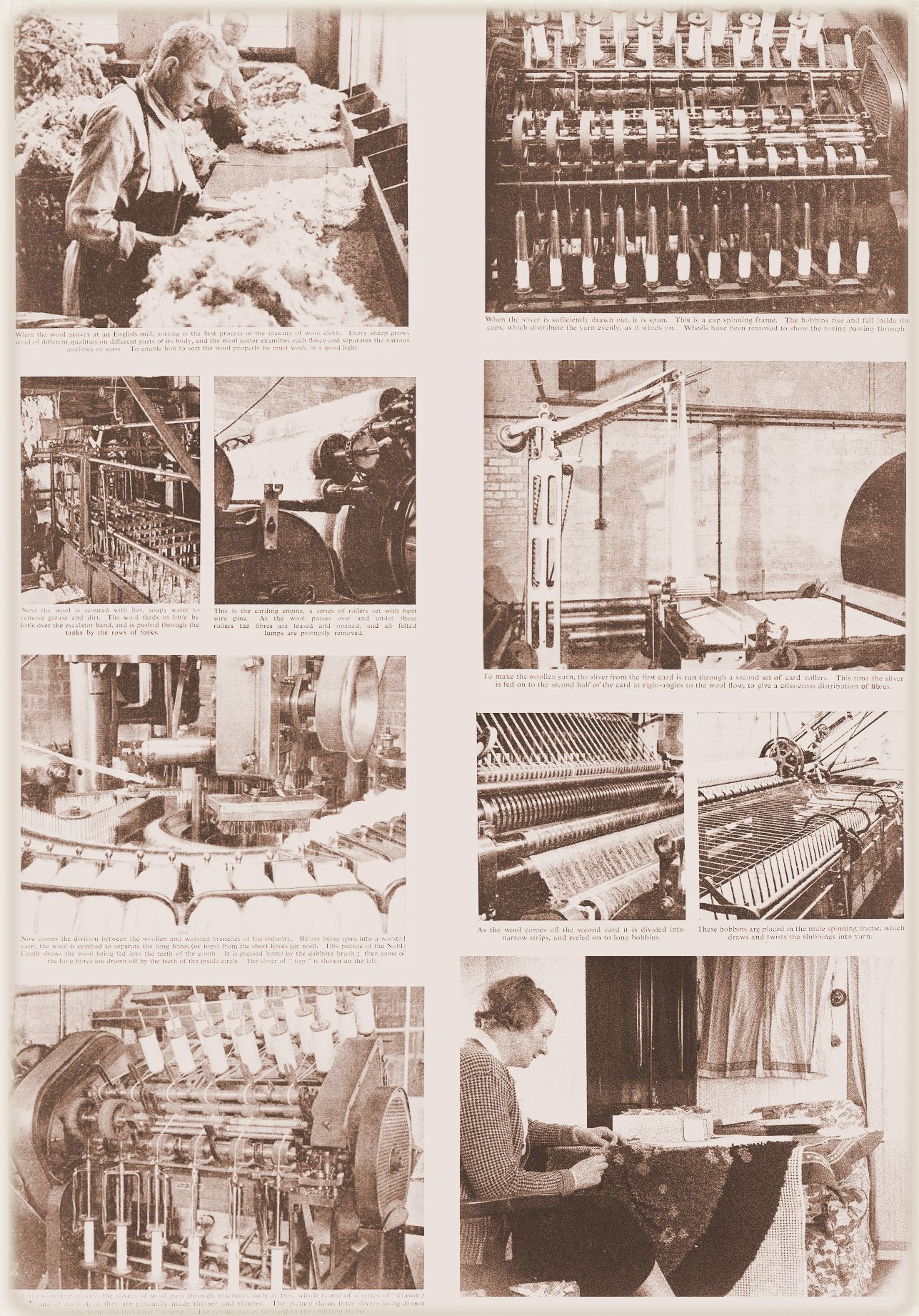 Rug yarn suppliers were often keen to educate their customers in how their product was made. |
RUG SUPPLIES (INCLUDING VINTAGE YARNS AND KITS)
MODERN RUG WOOL AND KIT SUPPLIERS
These days I bulk buy pre-cut packs from Iriss (their own brand). Iriss also stock Anchor rug wools, which seems to be the main brand stocked in knitting and sewing shops. Well into the 1980s, Readicut was widely stocked in shops in 2 pack sizes (320 and 160 pieces; though kits might contain 80 piece packs as well), and craft shops were happy to order shades in bulk for their customers. When my local craft shop closed I couldn't find any local sources of rug wool, so I made regular pilgrimages to Selfridges in London for packs of Coats rug wool. These days I can buy Anchor packs in a local knitting and sewing shop, and larger quantities using the Internet. Iriss also stock balls of rug wool for cutting at home; which is essential when making deeper pile rugs. Skeins are sometimes available, but I find them awkward to unravel and cut.
Balls or skeins of wool can be cut to length using Patons "Turkey Rug Wool" cutter - a simple but effective design comprising a length of wood with a lengthwise groove along one surface. You wind the wool around the wood (heeding the warning "do not double wrap") and cut along the groove. You can increase the strand length by nailing a thin piece of wood to the bottom of it. These wooden cutters also turn up second hand, but are not hard to make. All mine are for stand length pieces, but you used to be able to buy different size wooden guides for different depth of pile.
Synthetic and semi-synthetic fibres are hard-wearing, colour-fast and washable hence their appeal. In yarn form they have a silky texture. If used until worn out and then recycled (either into plastic pellets for reuse, or shredded as insulating fibre in garments) these have a carbon footprint similar to natural wool. However, in the modern “disposable” society, these decompose slowly in landfill sites, or produce toxic fumes when incinerated, hence they contribute to environmental problems.
Shillcraft (not the same as Readicut Shillcraft) produce a number of lovely designs, but their kits use 2 x 3 ply (equivalent to 6 ply) acrylic yarn – I’d certainly try one second hand! Once again, I’d prefer to buy those patterns in chart form and use pure wool. Caron kits use acrylic yarn and 4 hpi canvas, but most of their designs are too cutesy for me. Vervaco also produce rug kits with acrylic yarns. The patterns may be lovely, but I’m very biased against acrylic yarns. Anchor acrylic yarn rug-kits use a higher hole count to give a tighter pile and more detailed patterns. Mary Maxim is a Canadian company, founded 1954 and still trading, whose rug wools and kits can be found online.
If you’re just starting out, choose a kit that you find attractive, that isn’t too large, and then see if latch-hooking is for you!
Rug wool from historical suppliers still turns up often on ebay or in charity shops.
 Rug yarn suppliers were often keen to educate their customers in how their product was made. |
Anchor (formerly Coats)
Anchor Mills was built for John Clark, of Paisley. The Clark family were successful thread manufacturers and, along with the Coats family, established Paisley as a world leader in thread manufacture. The Clark company logo was an anchor, hence the mill's name and the brand name of the products. Clark became part of Coats & Clark, which became Coats plc who still own the Anchor brand. Coats & Clark entered a rug-craft marketplace ominated by Readicut and Patwin (Patons & Baldwin), but ultimately bought out Patons & Baldwin. Anchor is probably the most widely available pouches of pre-cut wool, though I'm sure I used to buy pouches of Coats brand rug wool from Selfridges in London back in the 1980s when my local supply of Readicut dried up. A decade or more earlier, Coats also produced rug making catalogues and kits. Anchor produced some charted kits sold by third parties with pure wool yarn. There are also Anchor rug kits using acrylic yarn on 4.5 hpi canvas which gives better detail and a pusher pile though personally I’d prefer to buy the pattern chart and use Iriss or Anchor wools on 3.3 hpi.
Iriss
My personal favourite, Iriss produce their own rug wools in colours compatible with Anchor (they also stock Anchor wools). I use Iriss wools for most of my rugs, only switching to Anchor if there isn't an Iriss equivalent. You can mix Iriss and Anchor yarns in the same rug without affecting the texture. Iriss also have some lovely kits, that I’d love to make were I not producing my own patterns! Their pure wool range of designs come from Georgina Martin, Mariarosa Martin, Susie Huntington, Alison Davies and Anchor (the same as the Readicut / Craft Collection Homemakers) range.
Junghans-Wolle
In 1950 Erhard Junghans opened the first Junghans dealer in Aachen. This led to the birth of the Junghans-Wolle mail order company in 1954. Today, there are Junghans-Wolle Creativ outlets in Germany, Austria and Switzerland by catalogue, as well as the Aachen store. Junghans Wollversand GmbH & Co. KG is still family owned and managed by Dieter Junghans (managing partner) and Ulf Berg Johann (Managing Director). In addition to other textile crafts, Junghans-Wolle offers a wide variety of latch-hook kits and yarns. Some are the familiar Disney kits and others are Oriental, Berber or modern designs. These are mostly made with Junghans Acrylsmyrna wool (100% acrylic) in cut packs. 50g balls of Smyrna wool is available in a limited colour range (cream, brown etc). The rug-related services available from this company suggest that Germans, Austrians and Swiss are more enthusiastic rugmakers than Britons.
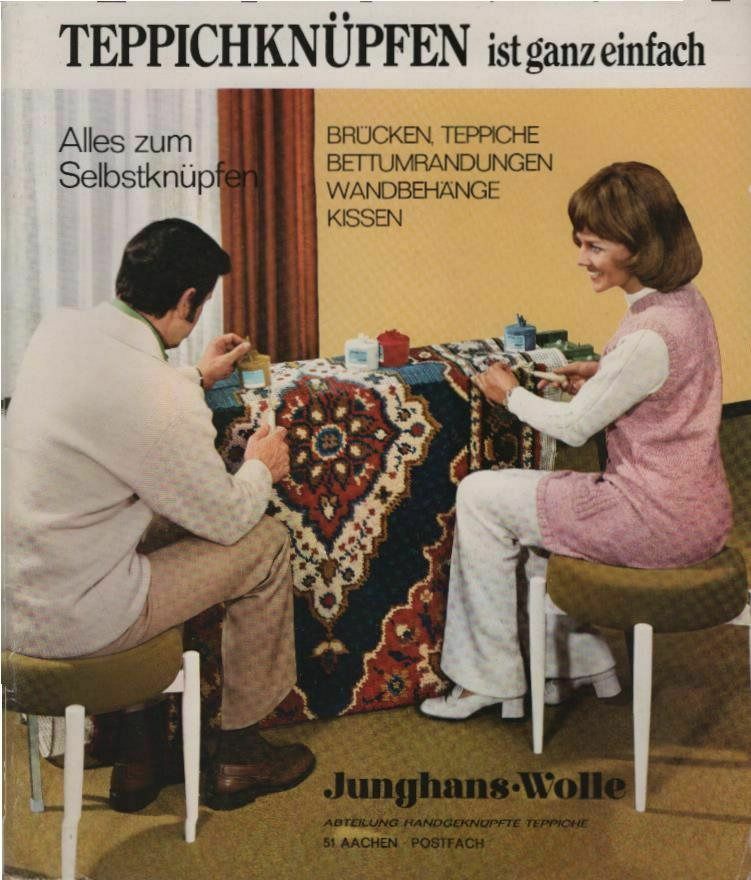
What really puts Junghans-Wolle in the Readicut mould of yesteryear is their customisation service. If the colour scheme of a chosen design doesn't fit your home decor, they can customise the colour range. Many of their designs can be scaled up or down. They even offer format changes: changing a design from square to round, oval, triangular or octagonal are not a problem for Junghans-Wolle. They then go beyond the Readicut model: if you don't have time to make the rug yourself, you can pay Junghans-Wolle to make the rug for you. If you make a start on one of their rugs, but can't finish it, you can pay them to complete it for you. They can also create rug patterns from photos and supply the appropriate amount of Acrylsmyrna. I have a 1978/9 Junghans-Wolle rug book, wool samples and other ephemera.
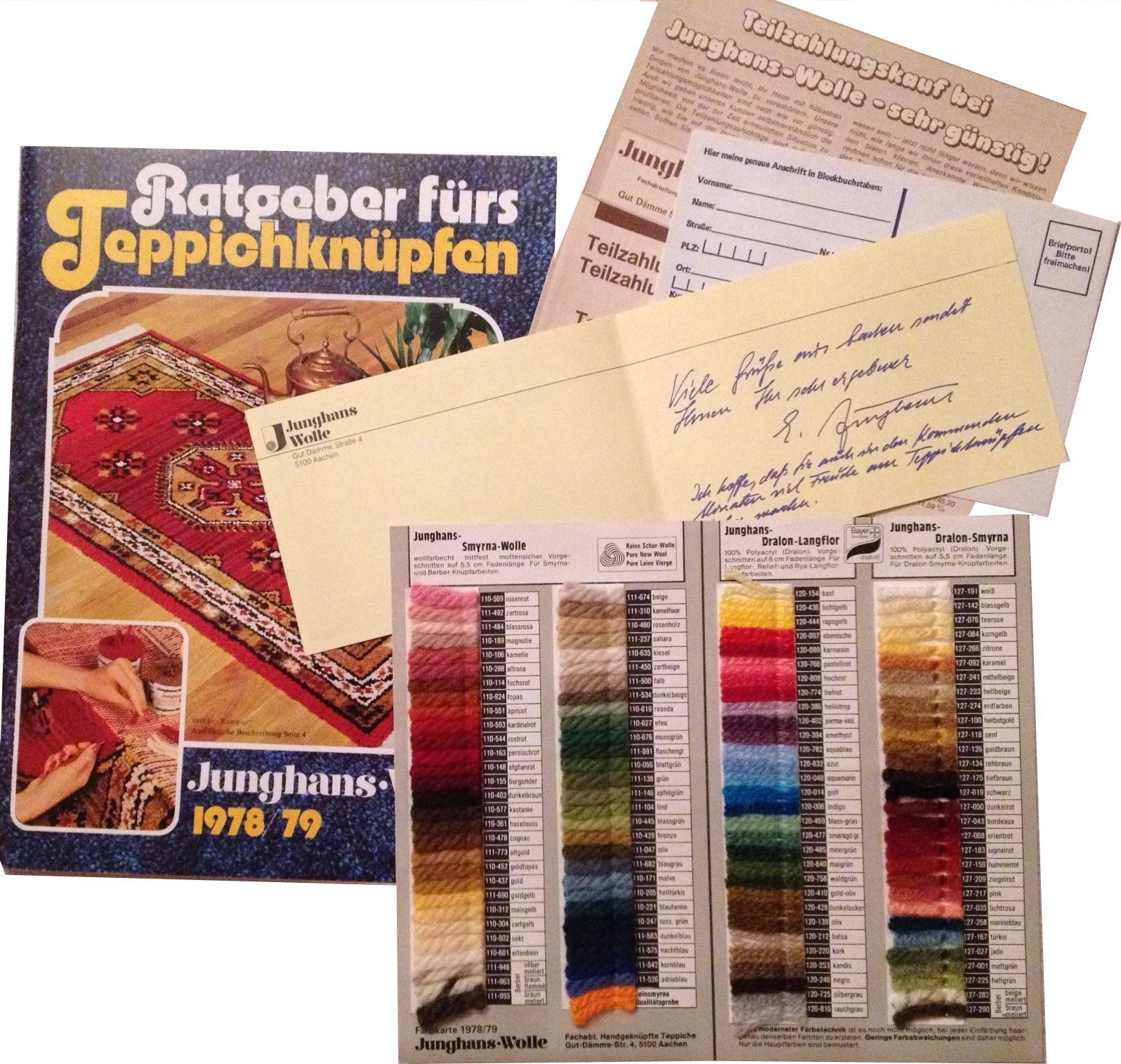
Mary Maxim
Mary Maxim is a family-owned hobby mail-order company with offices in Port Huron (Michigan), Paris (Ontario) and a retail store in Toronto. They produce their own brand rug kits, their own brand 100% acrylic 4-ply rug yarn and sell latch-hooking accessories. The company began in Sifton, Manitoba, Canada where Willard and Olive McPhedrain, began manufacturing and selling spinning wheels. Willard began a mail order company called "Sifton Products." In 1954 he relocated to Paris, Ontario. The "Mary Maxim" name honours the work of a shop girl called Mary Maximchuk. In 1956, Willard's son Larry expanded the company with an office in Port Huron, Michigan. In the late 1950s they became well known for patterns for chunky-knit sweaters. The company is now run by the third generation of McPhedrains.
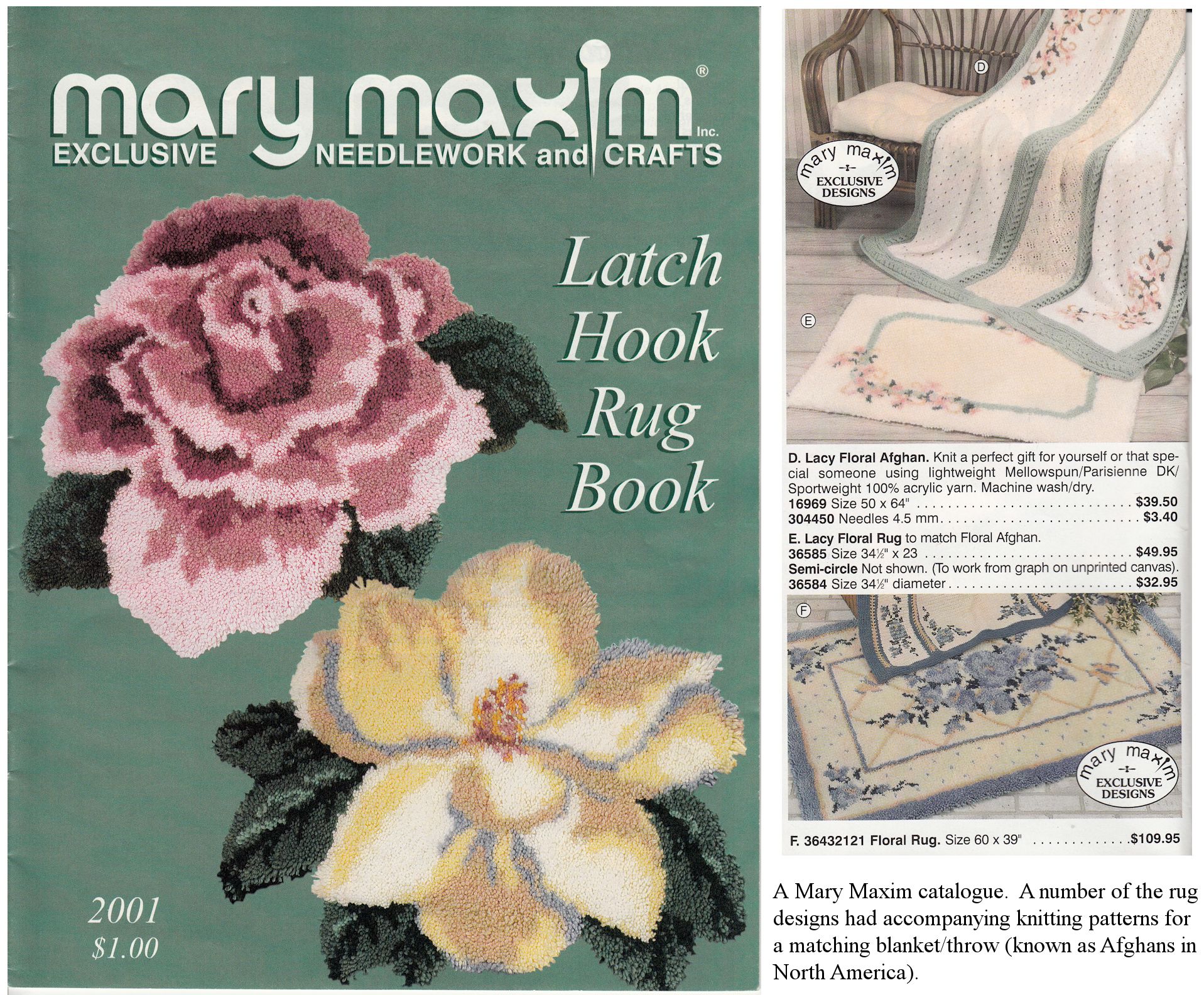
The patterns range from traditional florals and traditional and patriotic Americana to religious, wildlife, folk art and festive themes. A small selection from Volume 15 is shown below.

Semco (New Zealand)
Semco Rug Yarn was previously known as Coats Patons Turkey Rug Yarn and is now produced by Elite Crafts & Products Ltd in North Canterbury, New Zealand. Elite Crafts & Products Limited were founded 2010 and operate a trade only wholesale company. When Brandcorp Ltd (formerly Semco Crafts) closed, Elite Crafts purchased the original Coats Patons Turkey rug wool machine. They are reintroducing the full colour range of the rug wool plugs (packs) using 100% New Zealand wool. Brandcorp Pty Ltd evolved from a company originally founded in 1907. It designed, manufactured and supplied needlecraft and art products in Australia and New Zealand. Its predecessors include Sir William Holdings Ltd (incorporated in 2004), Semco Crafts (NZ) Ltd (2004 to 2008) and then Brandcorp Ltd from 2008 until dissolution in 2012. Semco Crafts Ltd also traded as Aotearoa Products Ltd (incorporated 2000, dissolved 2009). other business names for this company include Baci Beads, Finecraft Design and Maria George Craft Shop. The Sewcraft trademark was registered by Semco Crafts Pty Ltd in 2000 and expired in 2009. In general, this was a handcrafts and haberdashery operation.
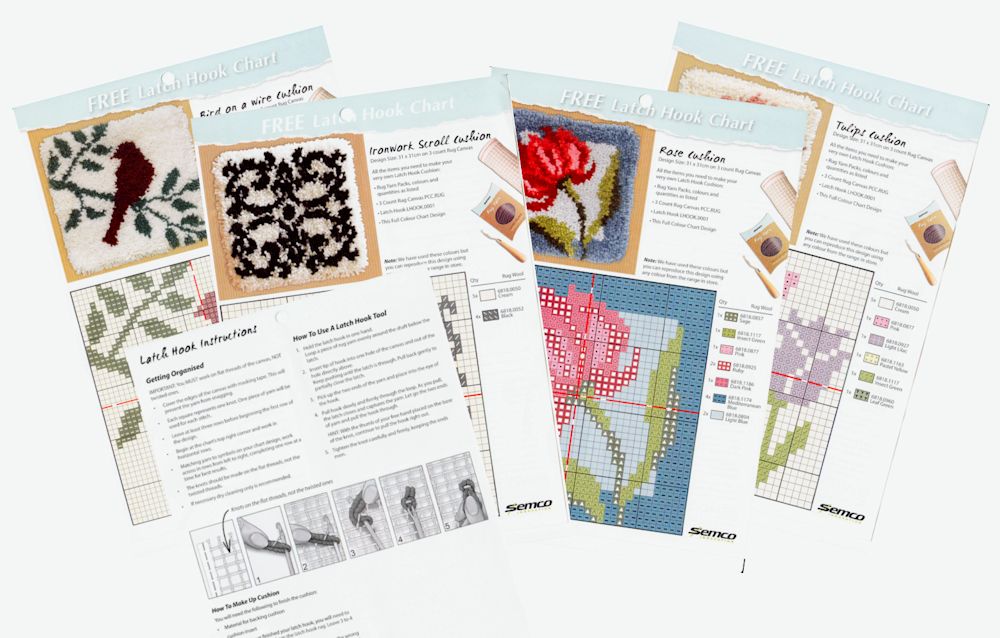 |
HISTORICAL RUG WOOL AND KIT SUPPLIERS
The 1950s to 1970s seem to have been the heyday of rug-making with the Readicut and Patwin (or Turkey) brands, dominating the market for rug-making yarns and supplies and Coats also having a presence. There were several companies producing rug yarns, some of whom also offered kits and design charts. Maybe it was the post-war era, with more women in the home, that saw people making their own rugs as well as knitting, crocheting and sewing their own garments. It was something you could do while listening to the wireless or gramophone in the evening. Some of these can still be found second hand; dug out of older relative’s attics. Common yarns used were Axminster, cable and worsted. Axminster is used in broad-loom carpet weaving and feels rough when the yarn is handled, but the cut pile is soft and resilient. Axminster thrums (loom offcuts) were economical to use, but it could also be bought in skeins. Cable is a thick yarn that is best pre-shrunk before use. When used in latch-hooking, only alternating holes are used because of cable wool’s thickness. Worsted is made from the long-staple pasture wool from long-wooled sheep breeds; the worsted preparation method involves combing rather than carding. Many rug yarns were described as worsted because of the production method which produced a weaving yarn rather than a knitting yarn.
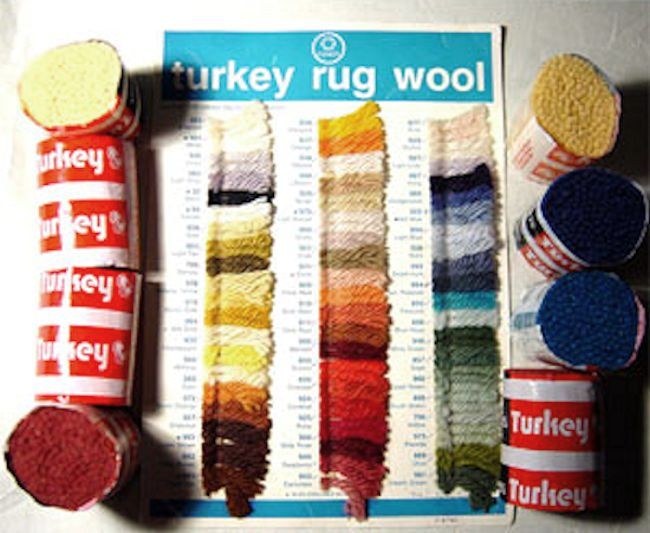
|
|
These are adverts for brands of wool and suppliers in the 1920s (before Readicut revolutionised rug wool). Most of it is for cable wool. Brands include J & J Baldwin, Patons, Sirdar and Stoddarts.
|
Below are notes on companies where I have insufficient information for a separate page, and short notes on non-British companies.
Archer. I know nothing about this brand, except for a rug wool gauge with the name and logo.

Aunt Lydia Yarns (The American Thread Company) Aunt Lydia's Heavy Rug yarns were produced by the American Thread Company (ATCO). The Aunt Lydia’s brand of heavy rug yarn (an acrylic/cotton mix) has long been unavailable, but some crafter recommend Caron’s 100% acrylic craft & rug yarn as a good replacement.
The American Thread Mills in Willimantic, Connecticut were originally constructed in 1857. The company commenced with linen thread, quickly changing to cotton, and eventually switching to synthetic textiles before closing in 1985 when operations moved first to North Carolina and then to Mexico. In 1896 there was a merger of J. & J. Clark; John Clark, Jr. & Co.; and J. & P. Coats, all based in Scotland, but having mills in the USA. In response, fourteen British firms merged during 1897 to form the English Sewing Cotton Co., Ltd. The English Sewing Cotton Co was originally established in 1789 by Thomas Dewhurst in Skipton, Yorkshire. It was registered as a public company “English Sewing Cotton Co“ in July 1897 when Algernon Dewhurst took over fourteen businesses. Coats & Clark and the English Sewing Cotton Co merged in the USA in 1898 after fierce competition.
The American Thread Company was incorporated in New Jersey, by combining thirteen New England firms, but the parent company was English Sewing Cotton Co. It bought up the stock of thread mills in Massachusetts, Rhode Island, Connecticut, and New Hampshire, including the Willimantic Thread Co. (Willimantic, Conn.), William Clark Thread Co. (Westerly, Rhode Island), Barstow Thread Co. (Providence, Rhode Island), Hadley Co. and Merrick Thread Co. (Holyoke, Mass.), Kerr Thread Co. (Fall River, Mass.), and several others. The English Sewing Company owned a controlling 60% of the ordinary shares of the American Thread Company – a controlling share. This made it hard for US companies to compete. In 1901, the main competitor for American Thread was the Coats operation. Coats was a British company and a significant part of American Thread was also owned by the British. Between them they produced around two-thirds of all thread used in the United States.
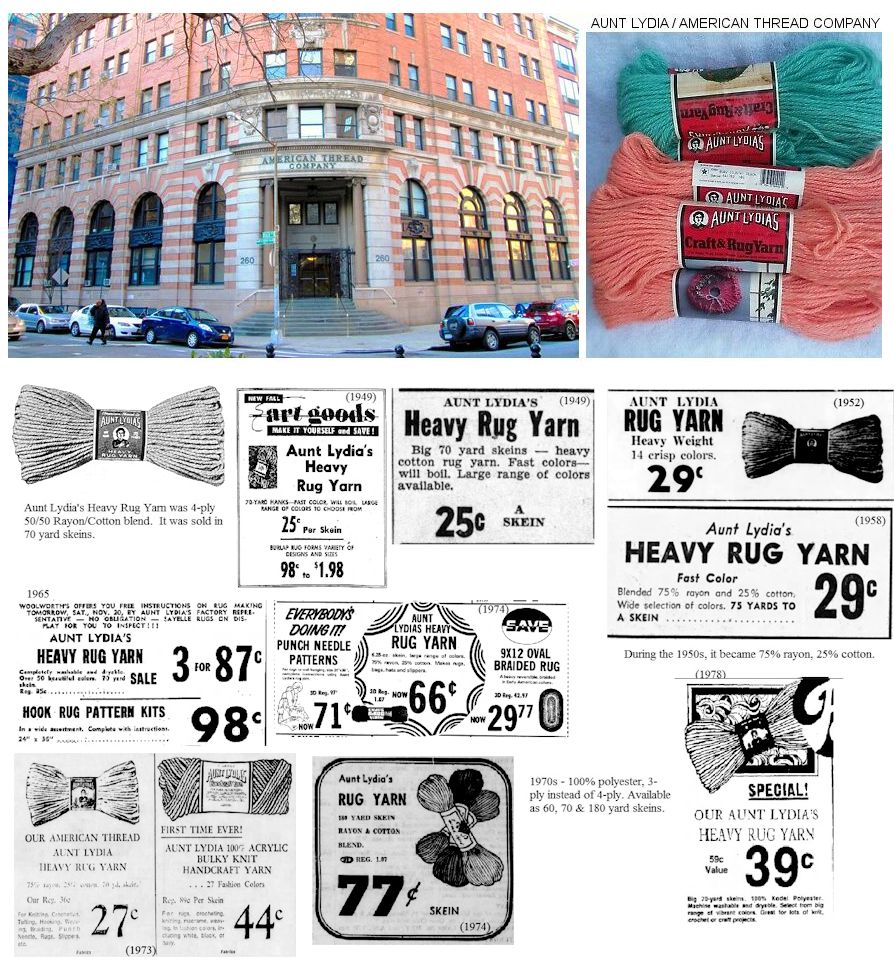
The 11-storey American Thread Building at 260 West Broadway on the corner of Beach Street in the TriBeCa neighborhood of lower Manhattan, New York City was built in 1896 for the Wool Warehouse Company and was originally known as the Wool Exchange Building. The venture was unsuccessful and the building was acquired by the American Thread Company in 1907, and occupied by them until 1964.
In 1914 an anti-trust (anti-monopoly) lawsuit dissolved the monopoly held by American Thread and J. & P. Coats, Ltd. The American Thread Company continued to operate after restructuring and splitting from their British partners. By 1948, the subsidiaries of the English Sewing Cotton Co included American Thread Co (Inc) and American Thread company of Canada Ltd. In 1963, supported by ICI and Courtaulds, English Sewing Cotton Co acquired the holding company Tootal Ltd. In 1968 it merged with the Calico Printers Association to form English Calico. In 1973 it became Tootal Ltd, then Tootal Group PLC in 1982. Around 1985, when American Thread was a subsidiary of Tootal Group PLC, it moved to Charlotte North Carolina . At around the same time Standard Coosa Thatcher (SCT) merged with American Thread Co. SCT was renamed the Standard Mercerizing and Specialty Yarn Co. in 1987 (and ceased trading in 2001). Tootal Group PLC vanished when it merged with Coats Holdings in 1991, and the company became part of the Coats Viyella Group – a successor company of J. and P. Coats of Scotland. So it has pretty much gone full circle with Coats again controlling English Sewing Cotton Co and American Thread Co.
A number of "Star Books" were issued showing the many different uses of Aunt Lydia's Heavy Rug Yarn. Although knitting and crochet patterns were included, articles knitted or crocheted with the yarn reportedly did not hold their shape too well.
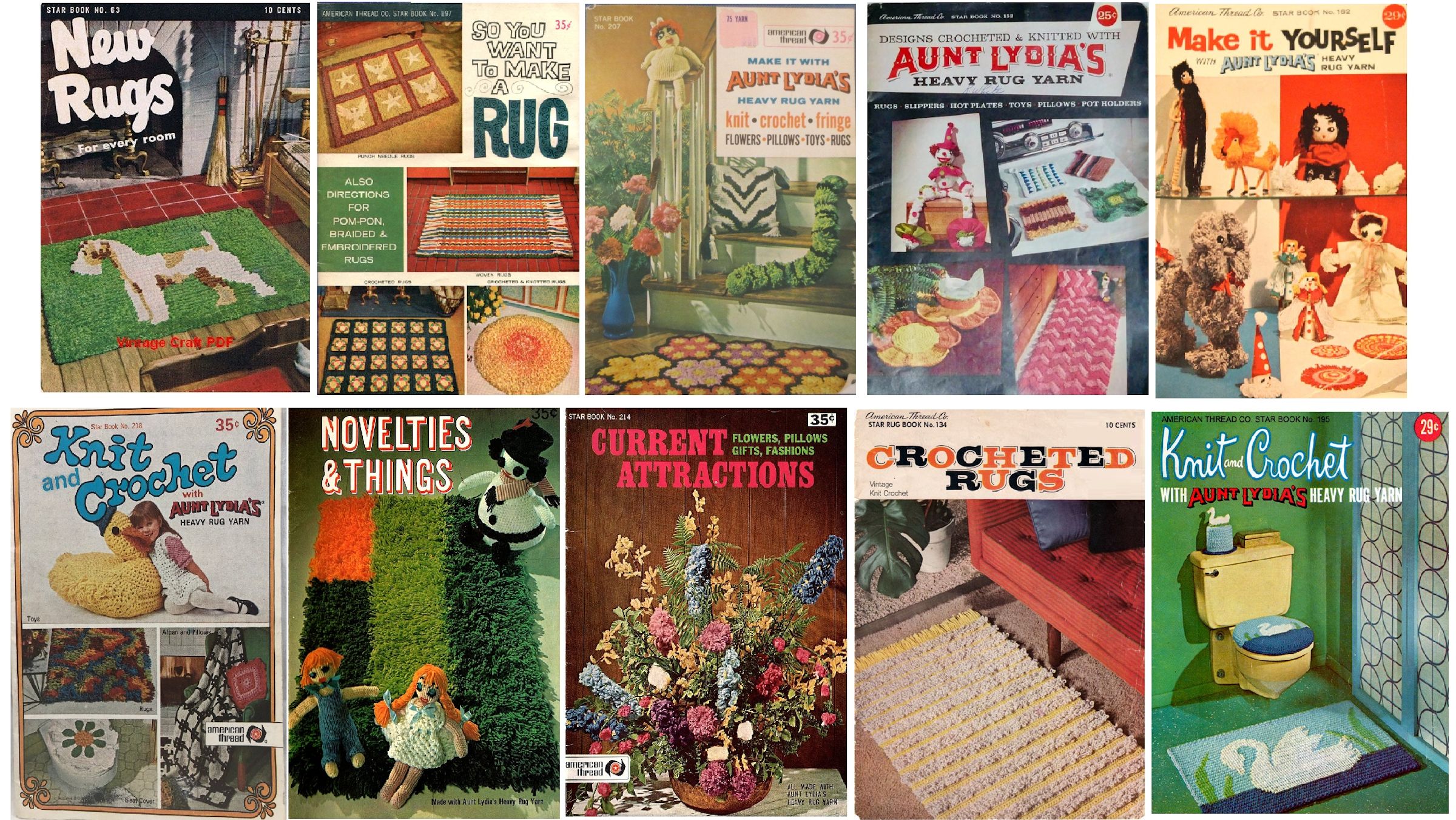
In January 2019, Spinrite (of Ontario, Canada) acquired the North American Crafts business of Coats which included the Coats’ brands Red Heart, Coats & Clark, Aunt Lydia and Susan Bates. The Anchor, Dual Duty XP and J&P Coats brands were licensed for varying terms. Spinrite produces both branded and private label craft yarns and was founded in 1952.
Bates & Co (Huddersfield) Limited, of Huddersfield, Yorkshire produced Batella brand yarn. The brand was registered in 1946 and expired in 1992 for yarn made mainly of wool or worsted. Bates Mill began life at the start of the 1900s as a spinning mill making woollen yarn. It is now operated by 2 brothers who are the third generation of the Bates family, but is now offices, studios and an event space.
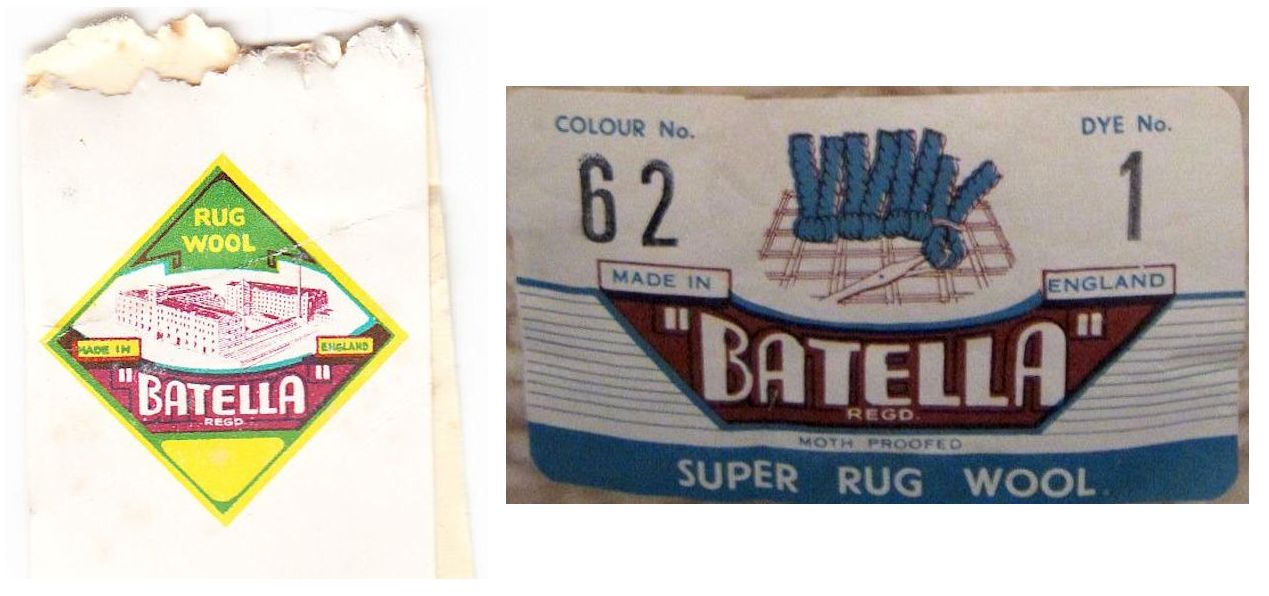
Borgs i Lund (Rya rugs) - a rya rug supplies company, imported into the USA by Copenhagen Imports. The text was often in Swedish, German and English. This is a 1967 catalogue.
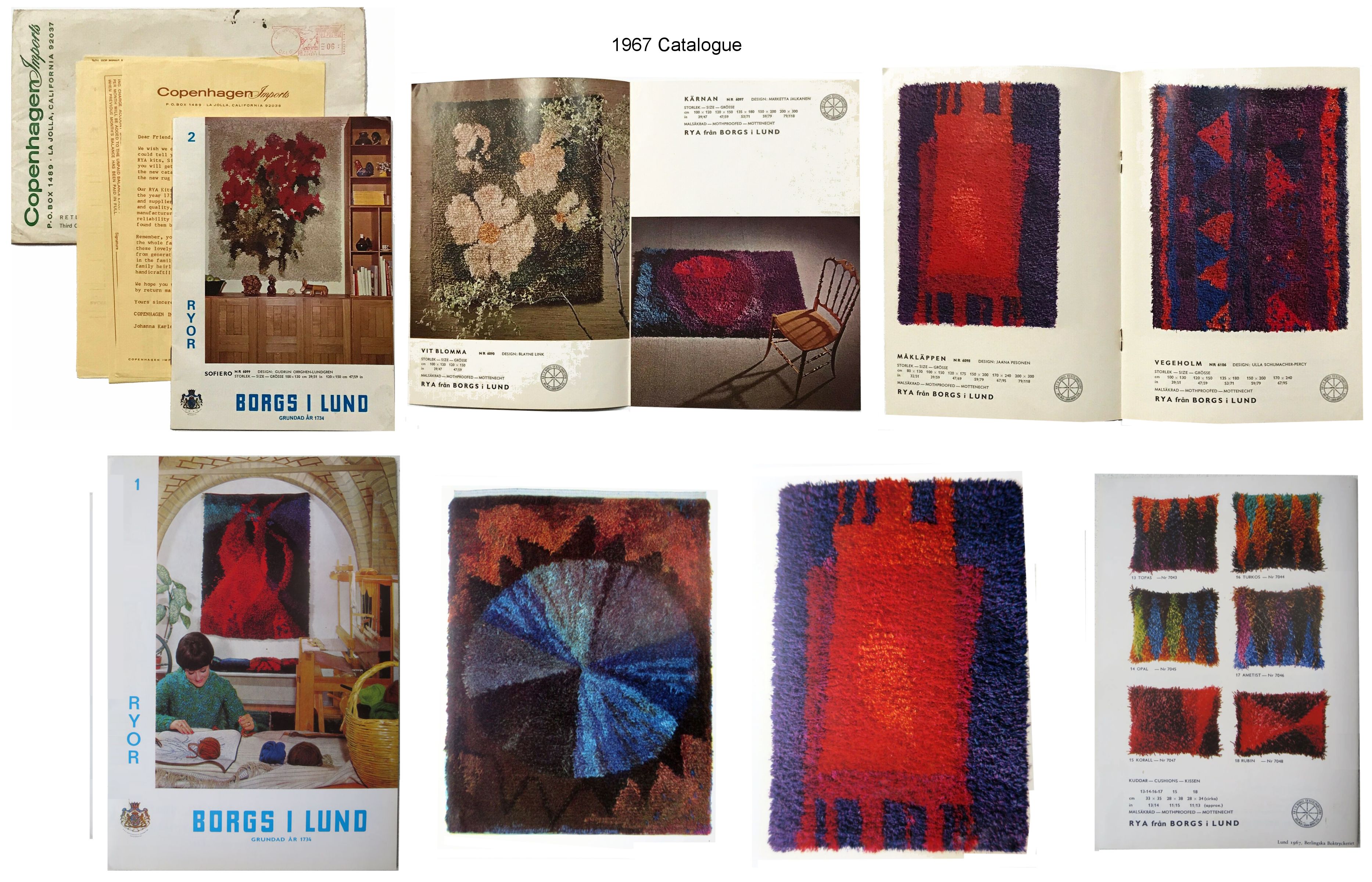
Boye Needle Company was founded in 1906 and manufactured precision crochet hooks and knitting needles, along with tatting shuttles and bobbins. It later became part of Newell Companies of Freeport, Illinois. Newell Companies began as W F Linton Company (incorporated 1902; bankrupted 1903) who made brass curtain rods. Edgar A Newell took control and renamed it Newell Manufacturing Company, Inc. and it expanded into other household fittings with a brass, zinc, or lacquer finish. In 1971 , as Newell Companies, Inc, it acquired the Boye Needle Company. Boye produced latch-hooking accessories including the “Cut Up” yarn gauge, canvases and latch-hooks. In 1985 Newell acquired a stake in home-sewing company William E. Wright Company (founded 1897) and by 1987 had complete control of Wright which it merged with Boye Needle Co. By 1989 it had sold off the William E. Wright/Boye Needle home-sewing business. The Boye trademark (first used in 1913; formally registered in 1949) was allowed to expire in 1992. In 2001 Conso International Corporation, owners of the Simplicity Creative Group, bought Wrights, but no longer produces rug kits or accessories under the Boye name.

|
Bucilla was founded in 1867 by Bernhard Ulmann, a European emigrant who lived in Woodside, New York. He originally sold napkins, doilies and handkerchiefs printed with silk-screened embroidery designs from a hand-barrow on the streets of east New York. In 1870, he opened a retail store and in 1875, he began to sell his products to other retailers. His company was Bernhard Ulmann Company, Inc (Lace, Linen, and Accessories), which was later shortened to its acronym of Bucilla. In the early 1900s, the company developed Mellina knitting yarn which accounted for nearly 70% of Bucilla's total sales. its other products were needlecraft supplies and pattern books. Bucilla remained in the Ulmann family until 1922, when it was sold to its employees as an Employee Stock Option Purchase. The employee-owned Bucilla company flourished until 1962, when it was sold to Indian Head Corporation, a well-known conglomerate of the time. The popularity of hand-knitting was declining so Bucilla sold its mellina brand and concentrated on needlework kits, including latch-hook rugs. Indian Head was purchased by Hannson Trust, a Swedish company, who owned Bucilla until 1977. In 1977, it was sold to Armour-Dial, a division of Greyhound Corporation. Armour-Dial sold Bucilla to a group of private investors in 1983. In 1996, the company was purchased by the Dyson-Kissner-Moran Corporation and is now under the direction of Plaid Enterprises. Each time, Bucilla had to adjust to consumer needs and it evolved from a textiles seller and needlework company to a more general crafts company.
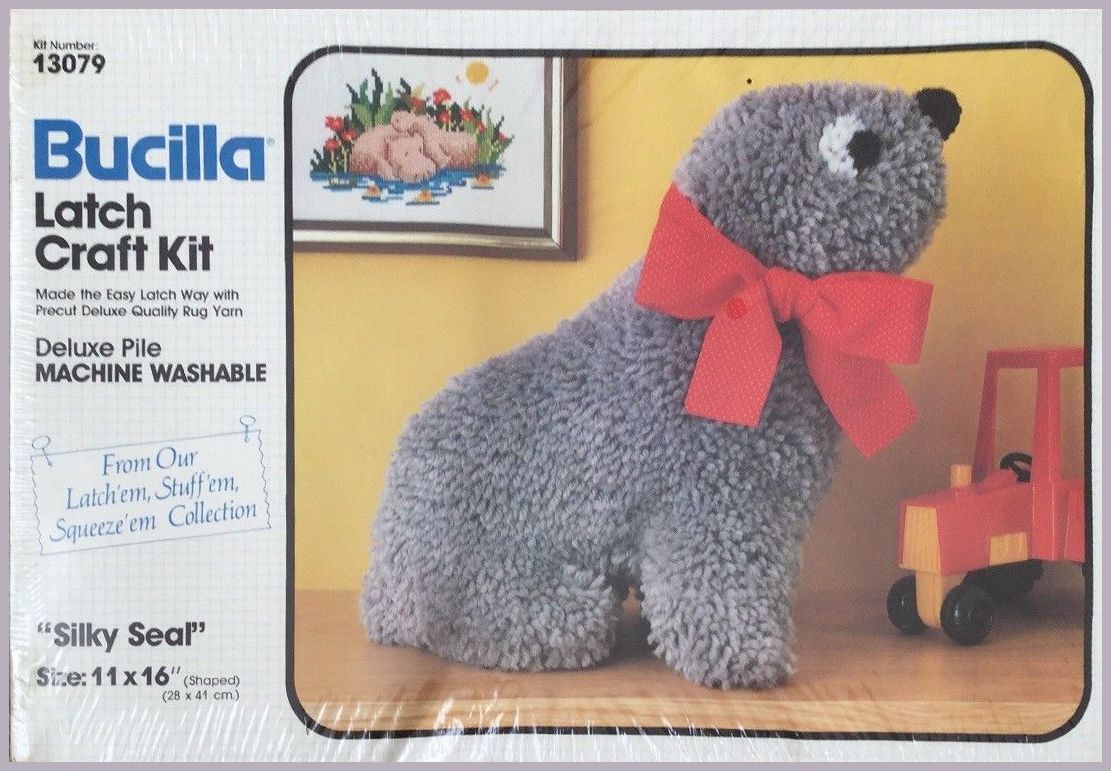
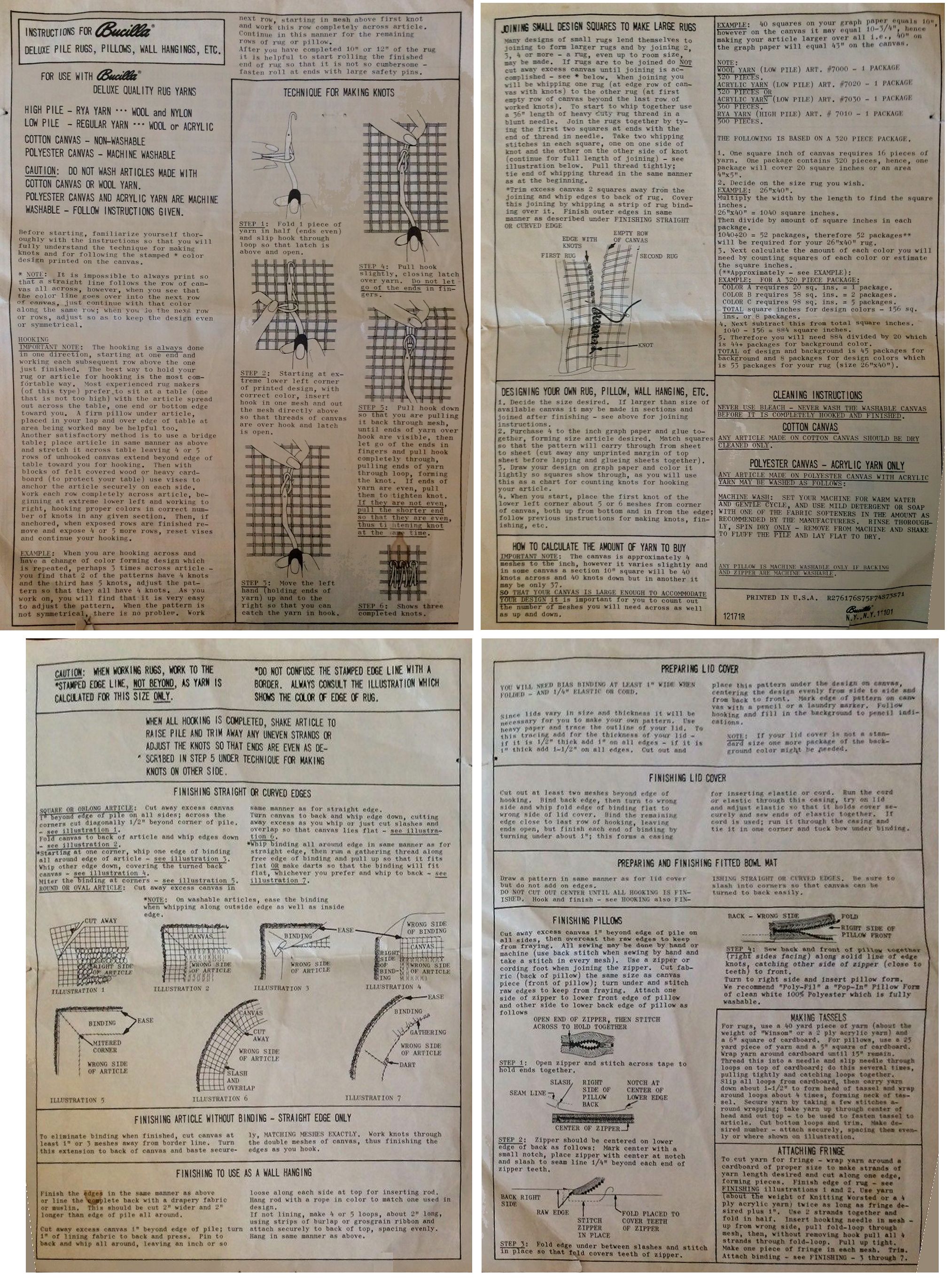
Columbia-Minerva Corporation and Caron - Edward C. Bettem was already well-established in the carpet industry in Carlisle, PA, USA, when he built a new factory in 1902 at Minerva Mills (The Minerva Yarn Mills). By 1936 E.C. Bettem & Son, Inc. had relocated and The James Lee & Sons Co were manufacturing their hand knitting yarns at The Minerva Yarn Mills. By 1955 James Lee & Sons had become part of the Columbia-Minerva Corp. In 1980, Columbia-Minerva became a division of Caron International. As well as yarns, Columbia-Minerva, and later Caron, produced rug yarns and latch-hook rug kits. Meanwhile, in 1929 William Mueller built a factory in Robesonia, PA where he manufactured women’s hosiery. During WWII, the vacated building was used for the manufacture of radio and radar detection equipment. In 1946 the building was sold to Caron Spinning Co. of Rochelle, IL to manufacture yarn. That company underwent several name changes and absorbed Columbia-Minerva Corp. Caron International became one of the world's largest providers of hand-knitting yarns, latch hook kits and knitting machines.
|
|
|||
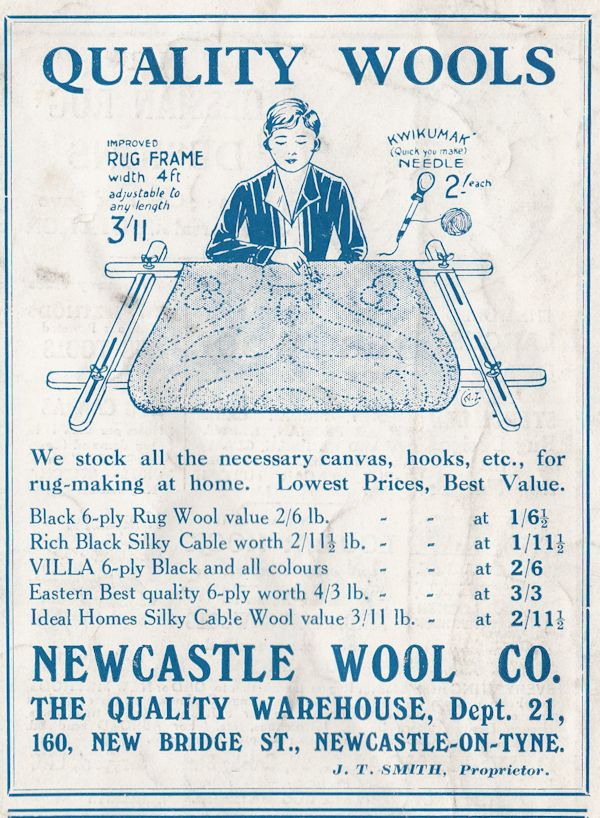 |
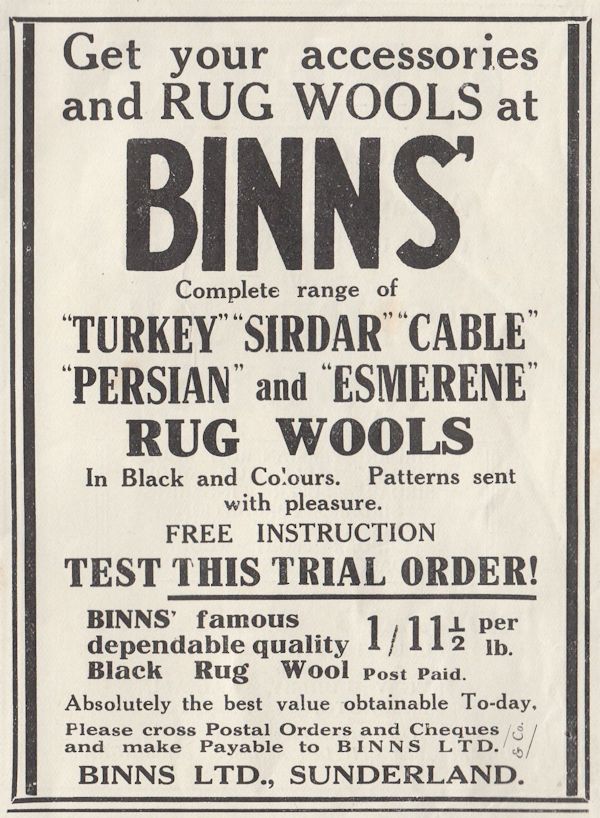 |
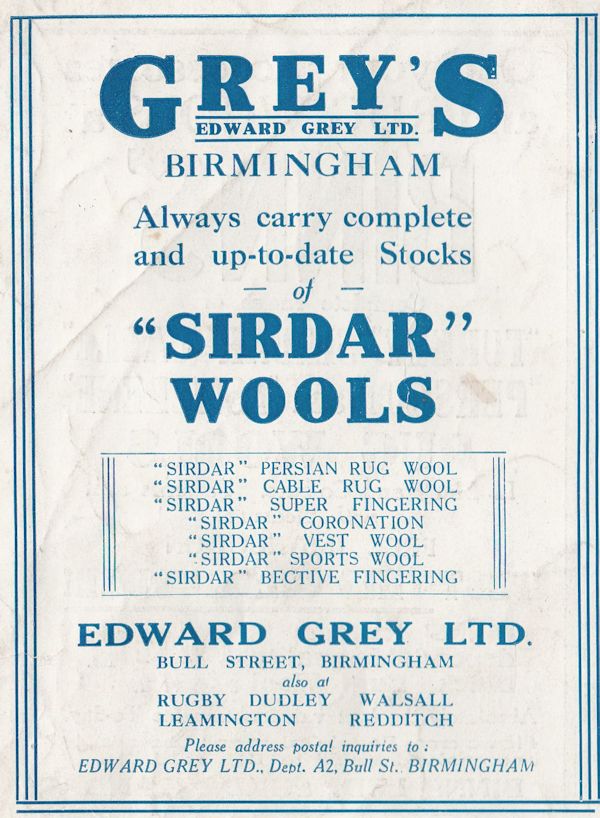 |
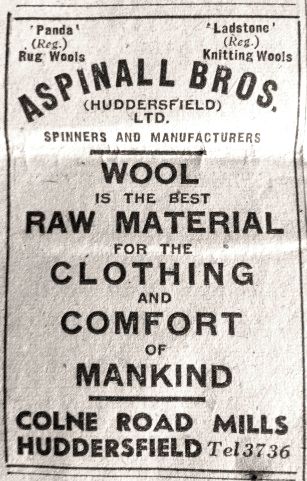 |
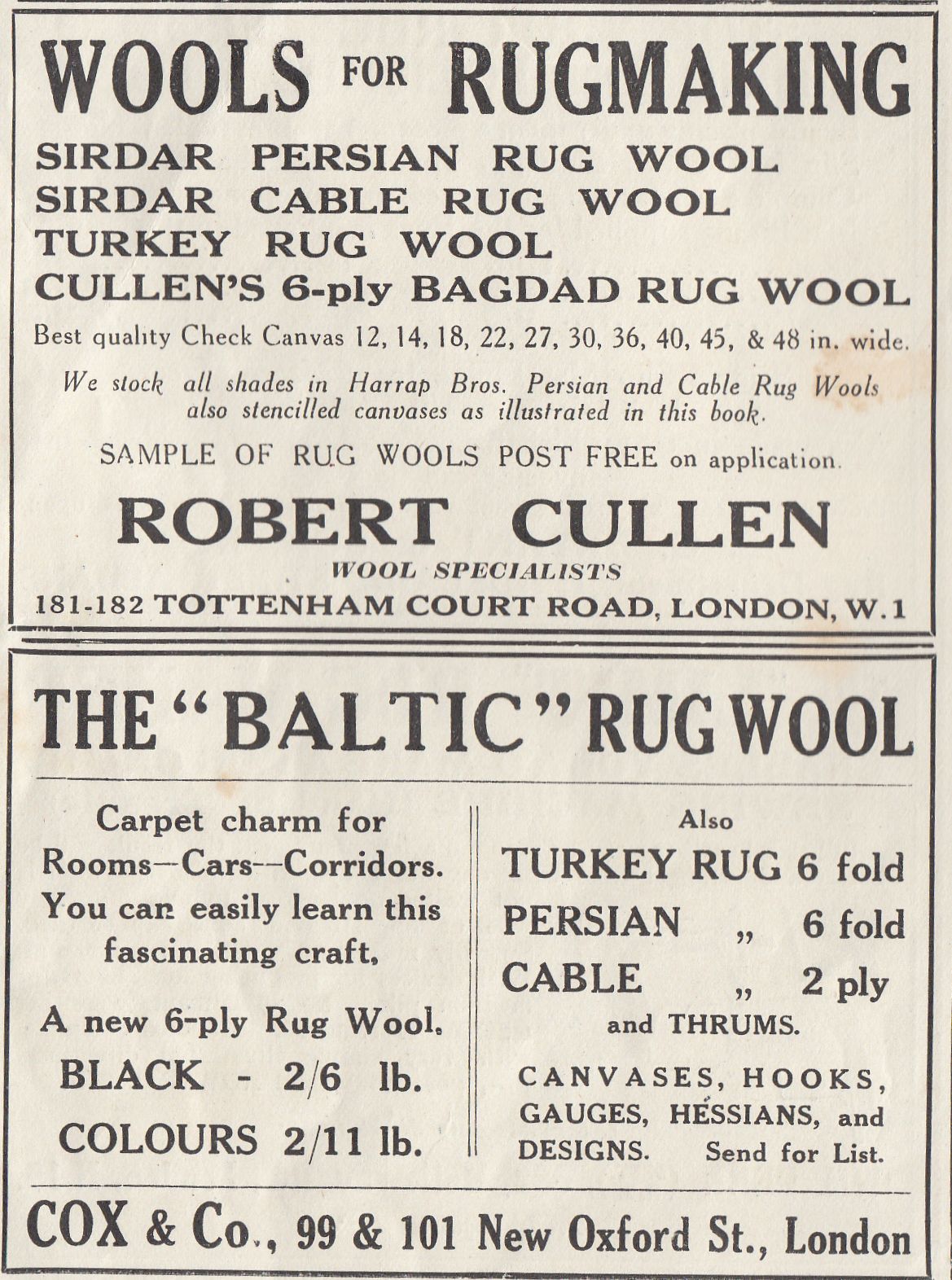 |
 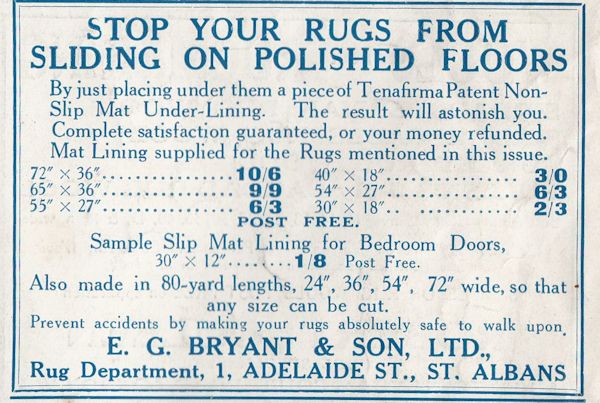 |
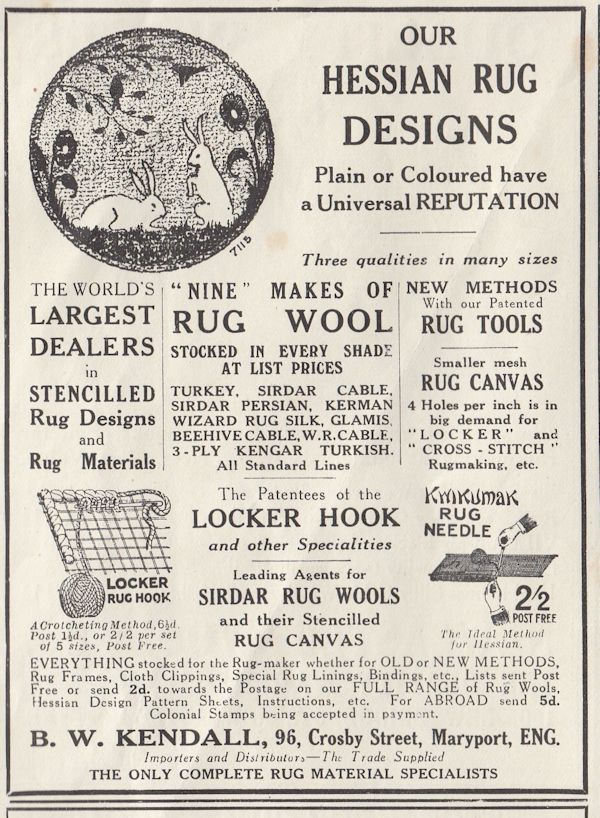 |
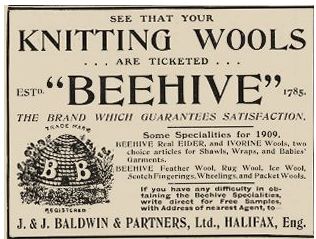 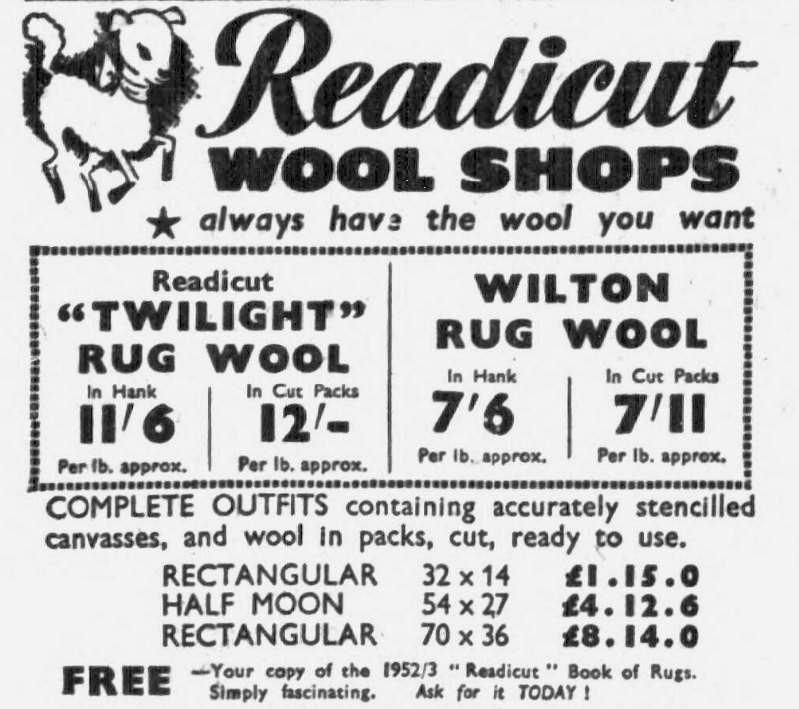 |
Dixon Rom - the charts are marked For rug making with eaase and pleasure" and the address is simply "Dixon Rom, London, N.8. I have not found any more information about Dixon Rom.
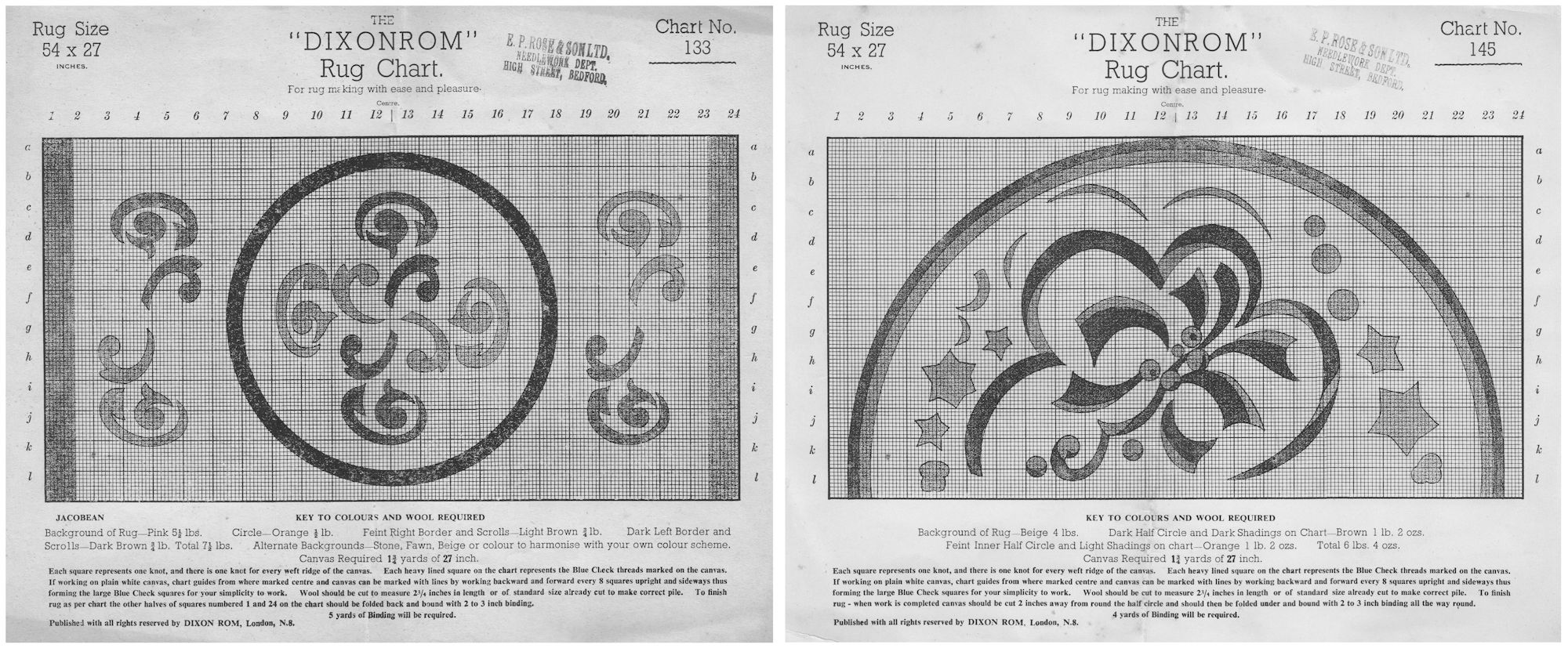
Emu Wools, trading from Emu House, Oxford Circus, London, W1 (Tel: Mayfair 7531) sold "Emu" Rug Wool in addition to their knitting wool (I have references to it from the mid 1940s to the 1960s). The trademark for Emu Rajah Rug Wool was registered on 12/12/1947 as "Classed 23. Yarns and Threads Yarns made wholly or substantially wholly of wool for use in rug making." The Dundee Courier (Dundee, Angus, Scotland) carried this advert on April 30, 1953: "EMU RAJAH RUG WOOL - 13/4 Per Lb. STENCILLED CANVASES - 4/11 to 21/9. STENCILLED HESSIANS - 6/11. AND A LARGE RANGE OF RUGMAKING ACCESSORIES. 82 PRINCES ST., DUNDEE”. The Emu brand is now owned by Thomas B Ramsden & Co. (Bradford) Limited (founded in 1960). This company also owns the Wendy and Robin brands. Thomas B Ramsden & Co have several subsidiaries including Richard Poppleton and Sons Limited (incorporated 1900) and Carter & Parker Limited (founded 1925). The now company produces hand-knitting wool and knitting/crochet accessories. Emu rug wools are no longer available.
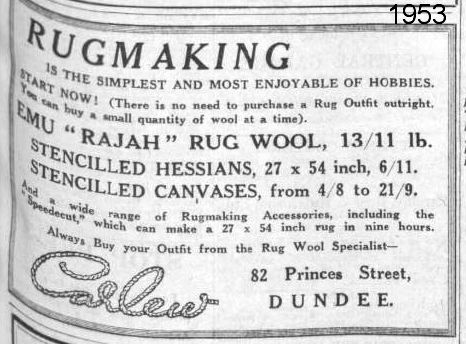

Falcon (Needlecraft International), a mail order company whose fliers were inserted into various magazines, offered a rug in its catalogue. It was a 3D rug, using mixed strand lengths worked in Tabriz wool. The koala design, with the onger strands for foliage, appears rather effective. This appears to be in the 1980s or 1990s.
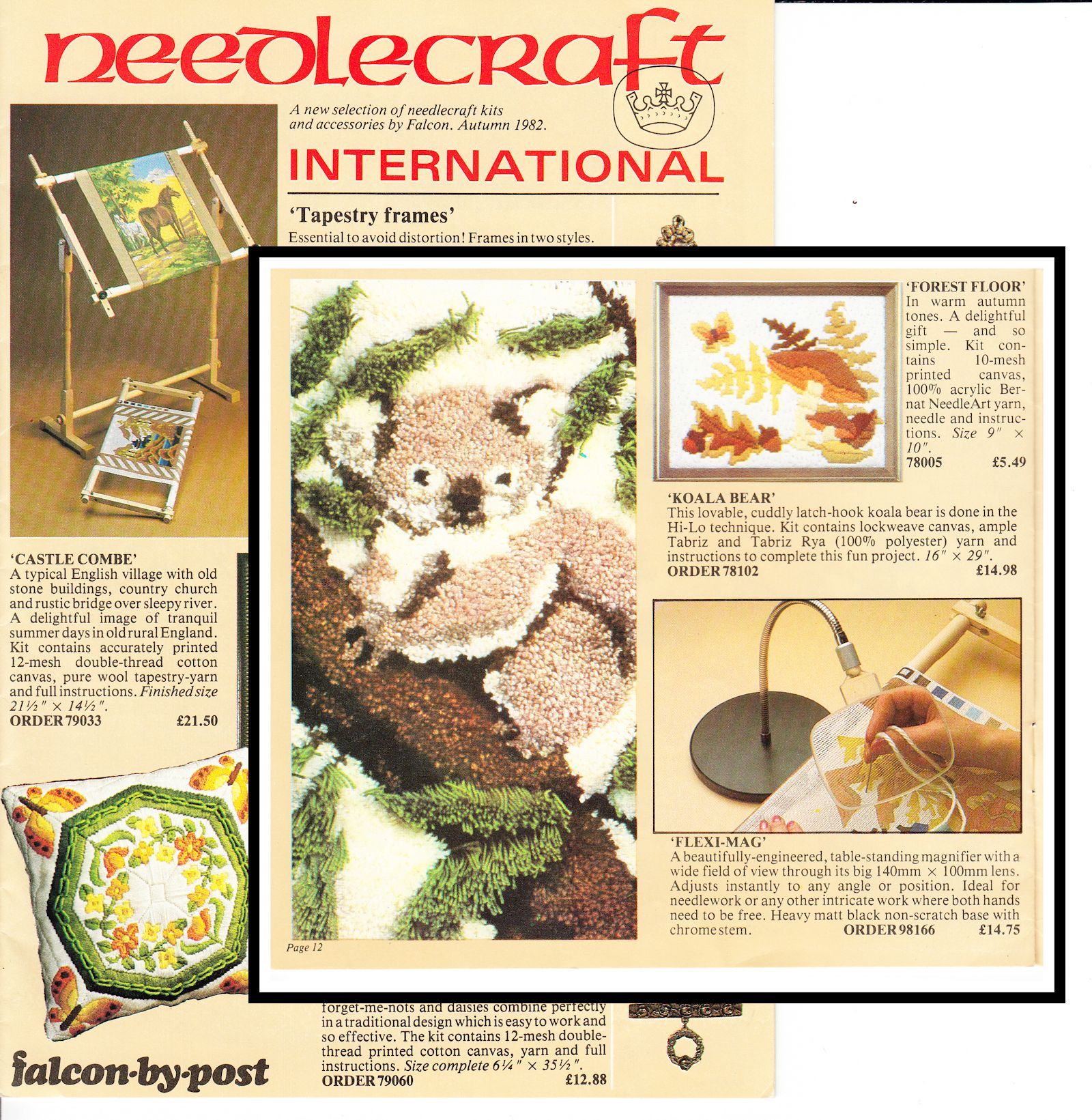
Granby Rug Wool was stocked by Rowe's Wool Shop (Leicester & Branches) whose flagship store seems to have been an impressive building at 70 Granby Street, Leicester (built in 1903 and notable for its three Wagnerian Viking heads and the ornate carvings in the panels between the second and third floor windows). This used to be occupied by Rowe's Wool Shop, but in January 1965 (according to the Leicester Mercury), rising costs and parking difficulties meant Rowe's had to move to 152 Evington Road, Leicester - over a mile away and 25 minutes’ walk from the Granby Street premises. Rowe's Wool Shop was established in 1909 in Granby Street by two brothers, Mr Shirley Rowe and Mr Claude Rowe, both of whom had retired by that time. Governing Director at the time of the move, Mr R G Pateman, was their nephew, thus maintaining the family tradition. Mr Pateman, explained that their difficulties began with parking problems about four years ago and this, combined with increased operating costs, had made it impossible for a small firm to continue to trade in Granby Street. A new warehouse was built in Rowsley Street behind the new Evington Road premises and Rowe's continued to supply to a string of eight shops at Burton, Nuneaton, Northampton, Peterborough, Rugby, Loughborough and Coventry from their Leicester headquarters.
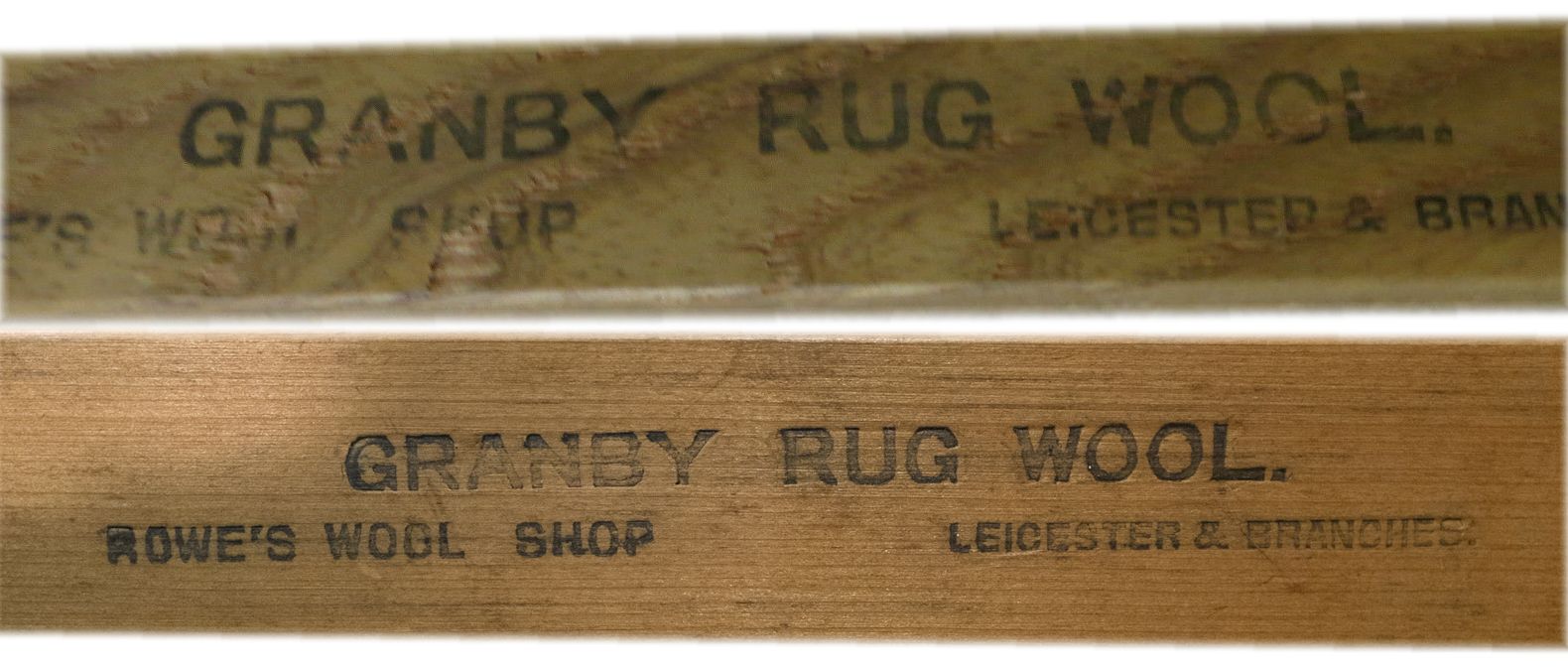
|
LeeWards Creative Crafts was a North American crafts and fabrics retailer founded in Elgin, Illinois in 1947. In 1994, it was purchased by arts and crafts chain Michaels Stores, Inc. LeeWards produced latch hook kits and accessories; LeeWards pre-cut acrylic rug yarn and branded latch-hooks can be found on online auction sites. LeeWards began with mergers of Rudolph Petzelt’s Chicago-based Mid-City Engineering Company with Elgin-based Collingbourne Mills, Inc. in 1943, forming Dexter Thread, Inc. Petzelt was only interested in the machinery, so former Collingbourne Mills employees Sidney Fink and Ralph Fried purchased the leftover Collingbourne inventory and in 1947, they registered their mail-order company as LeeWard Products Ltd. In 1948 they changed the company name to Dexter Thread Mills, Inc –confusingly similar, but unrelated, to Petzelt’s company, with LeeWards as a brand-name. They were heavily involved in nylon thread. In 1969 LeeWards became a division of General Mills, Inc. and became a store-oriented art hobbies and needlecraft outlet. By 1974 the LeeWards chain of retail stores were a huge success due to variety and pricing (with discounts on bulk buys). In 1985, General Mills Inc sold LeeWards Creative Crafts, Inc to Munford, Inc; a company that had recently moved into the arts and craft market with its “Craft Bazaar” store. Munford wanted to expand by acquisition and the chain became LeeWards Craft Bazaar. In 1988, LeeWards was bought by their Elgin-based management team backed by outside investors. It began to cater more for crafters interested in “quick gratification” rather than longer term projects which were falling out of favour. One of LeeWards’ main competitors was Texas-based Michael’s Stores and in 1994, the privately held LeeWards Creative Crafts, Inc of Elgin, Illinois merged with Michael’s.
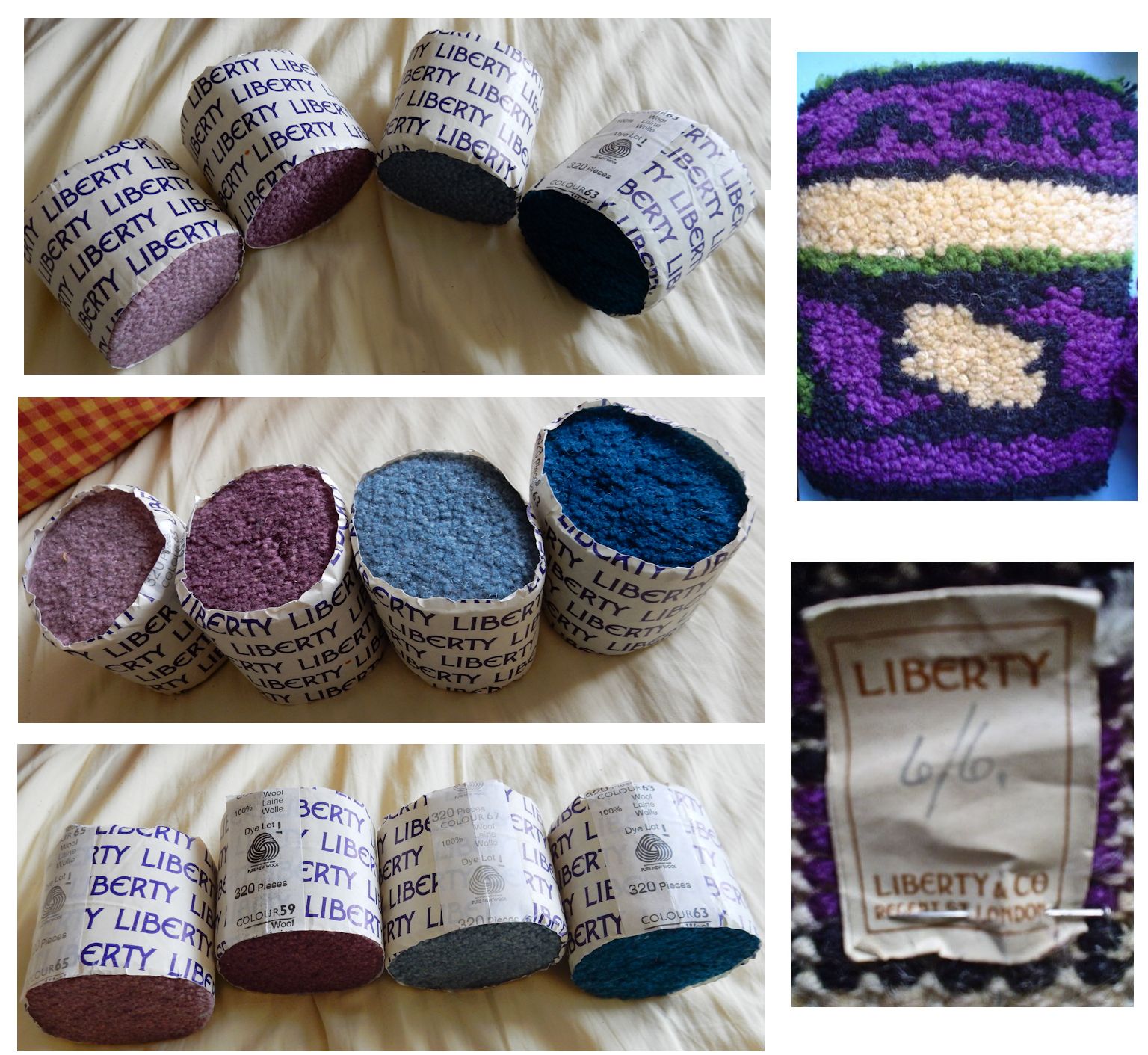 |
Liberty (the London store) branded packs of rug wool can sometimes be found at auction. I bought a vintage remaindered lot of Liberty rug wool; it's 100% wool and was almost certainly produced by one of the rug yarn main suppliers (I don’t know which) and labelled for sale at Liberty. Liberty of London was well known for selling Turkish and Oriental rugs and for their printed fabrics. The business was founded in 1875 by Arthur Lasenby Liberty, a former draper's apprentice who envisaged an Eastern Bazaar style store. His collection of ornaments, fabric and objets d’art proved irresistible to a society fascinated by all things oriental. By 1884, Liberty had expanded into fashion and fabric and had developed its soft palette of “Liberty colours.” Liberty outlets opened in major British cities as well as in the USA and France, although these were later closed in favour of a single flagship store in London. Liberty fashions kept track with artistic movements such as the Aesthetic Movement and Art Nouveau. In the 1920s, Liberty began producing small floral prints that became famous as Liberty Prints. As well as their Costume (clothing) department, the shop sold fabric, drapery and wool. I'm not sure what era the Liberty branded latch hooking wool fitted into, but Liberty did have an extensive haberdashery department.
|
One of my oldest rug wool adverts comes from the 1898 Price List and Diary of Spencer, Turner and Boldero Ltd. “Perseverance” Rug Wool has only a brief listing so I’ve included the illustrations for “Perseverance” and “Rodbard” knitting wools to give a flavour of that era. I’m guessing that the rug wool was cable wool. As an aside, Patons wools and Baldwin’s wools were also listed by type and weight. 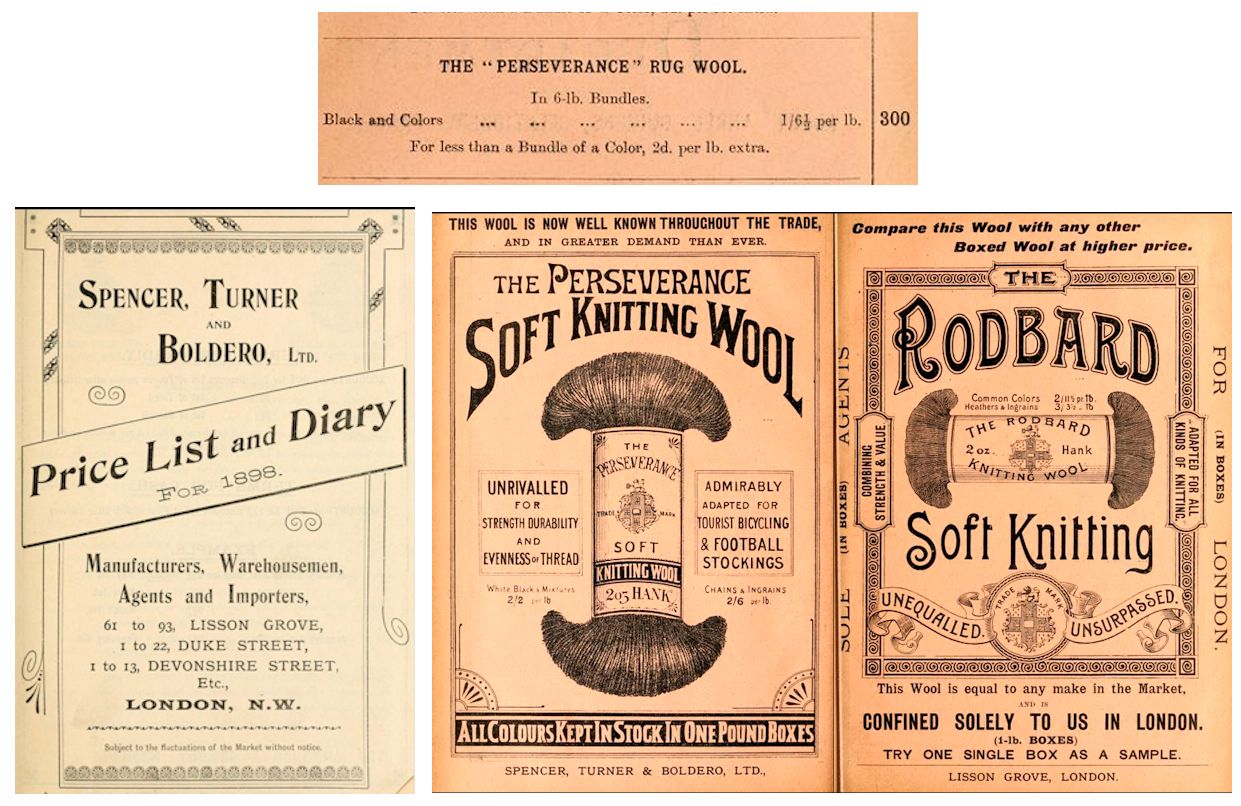 “Spencer, Turner and Boldero, linen drapers” began around 1855 on Lisson Grove, Marylebone, London. Much of Lisson Grove was run-down; in the 1890s homes were demolished to make way for the railway and the company diversified into wholesale dealers and "Textile and General Warehousemen, Drapers, Outfitters, Carpet and Furniture Dealers." This included the sale of wool and haberdashery. Their extensive corner premises incorporated 61-93 Lisson Grove and part of Duke Street (later Boldero Street), Devonshire Street (later Ashmill Street) and Exeter Street (later Ashbridge Street). By 1900 they were also tea merchants, wine and spirit merchants and "complete home furnishers" (a department store). They benefited from the post First World War housing boom in the immediate area. The company remained at 61-93 Lisson Grove as textile merchants until 1969 when the area was redeveloped into offices. |
MCG Textile who produce Graph'N'Latch is a family owned business founded in 1972. It produces latch hook canvas, rug yarn, rug kits and other needlecraft supplies and accessories at affordable prices.
Paternayan Yarn was designed and branded by two Armenian brothers, Harry and Karnig, who began selling their yarn in New York in 1916. In 1936, they began dyeing and marketing their woolen yarn. In 1986, it was sold to Johnson Wax and the dyehouse operation was moved to Pepperall, Massachusetts. It was then sold to Alan Getz who continued to develop the business. Saco River Dyehouse acquired the rights to the Paternayan line when they bought the Massachusetts-based Dyehouse. They are reintroducing the Paternayan lines of needlecraft and rug yarns.
Pedigree Rug Wool This one is a bit of an enigma. They sold wool in skeins that were equivalent to 360 cut pieces.
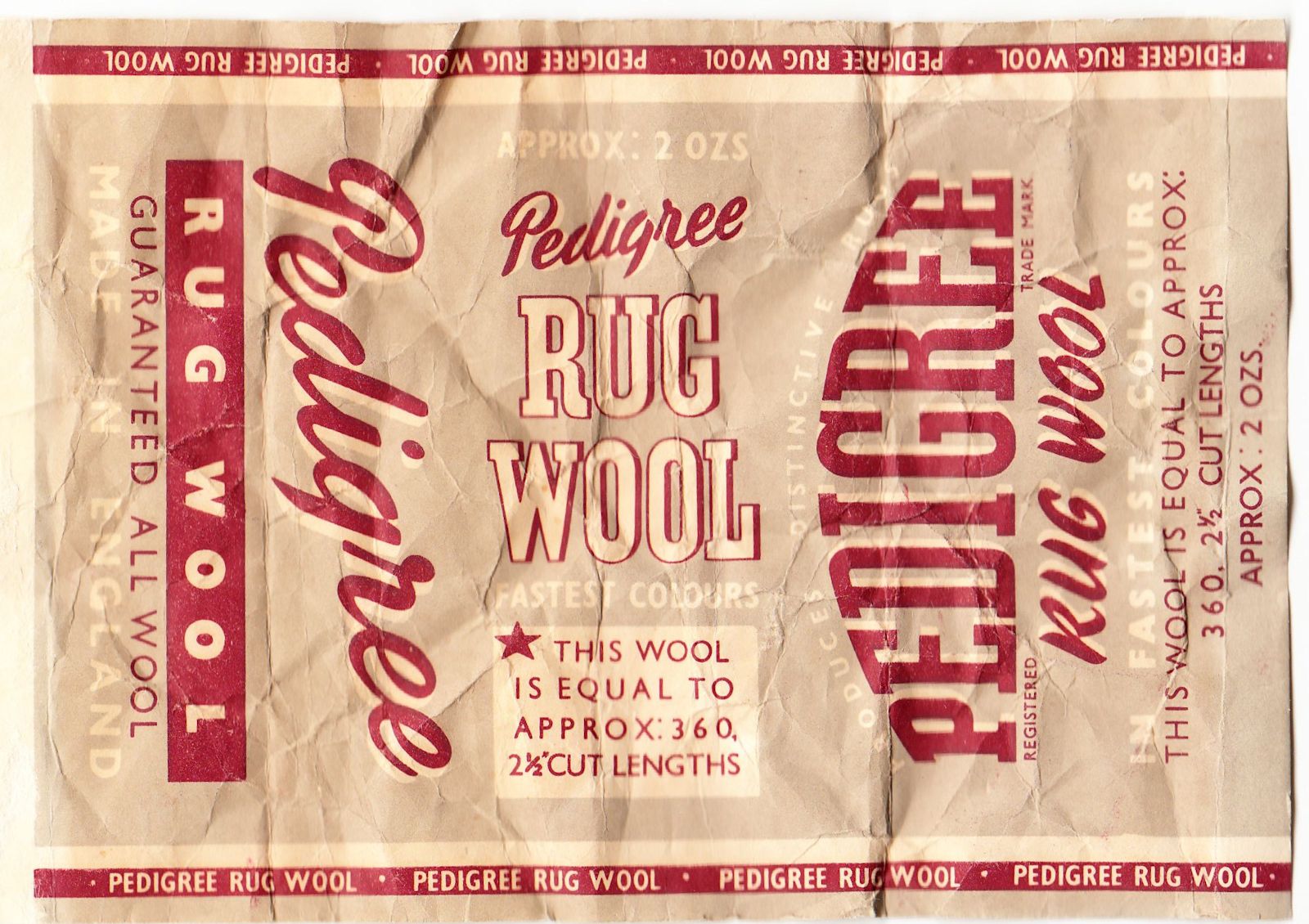
Perlon (Perlon Industries Inc, New York, USA) produced rug kits in the 1970s and 1980s. The company was founded in 1978 and dissolved in 1991. From what I've seen of their vintage kits available through online auction sites, the designs were along the lines of Wonderart, rather than being classic floor rugs. From the name, I'm guessing their rug kits used synthetic yarn. Perlon is a synthetic fibre similar to the American nylon and was invented by the German chemist Dr Paul Schlack at I.G.-Farben in 1938.
Phildar This one is a bit of a mystery. They produced rug kits.
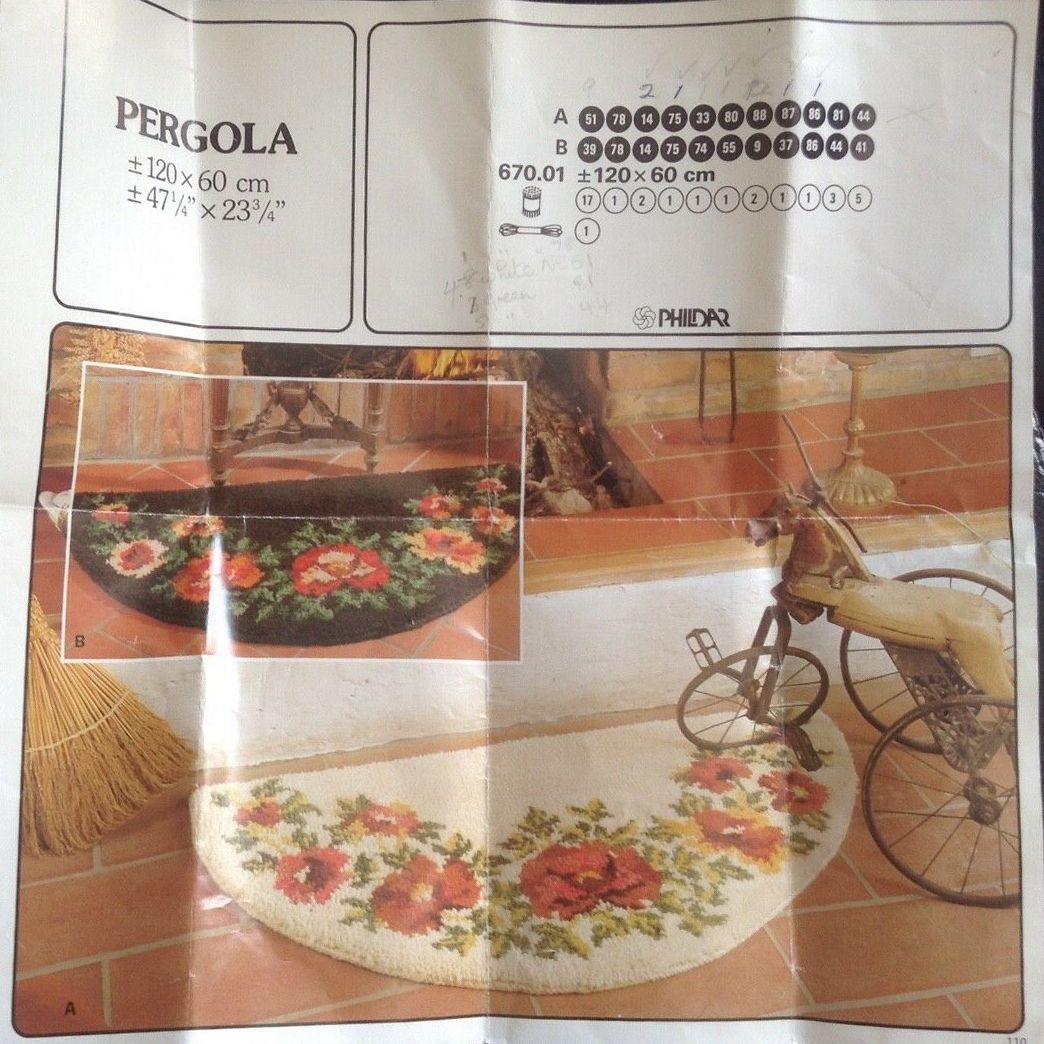
Pingouin Rug Kit
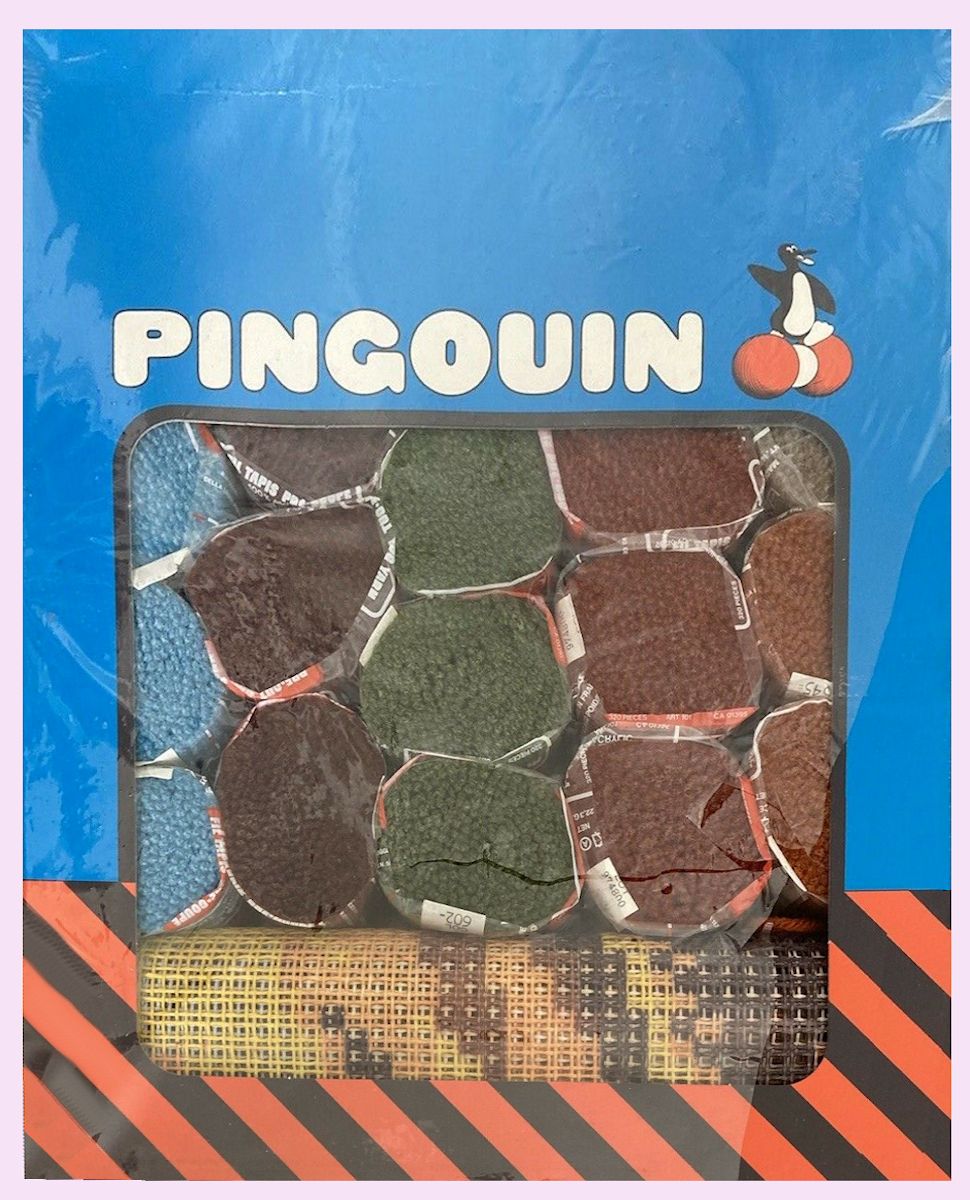
Promafil (Caravelle) This one is a bit of a mystery. They produced rug kits.
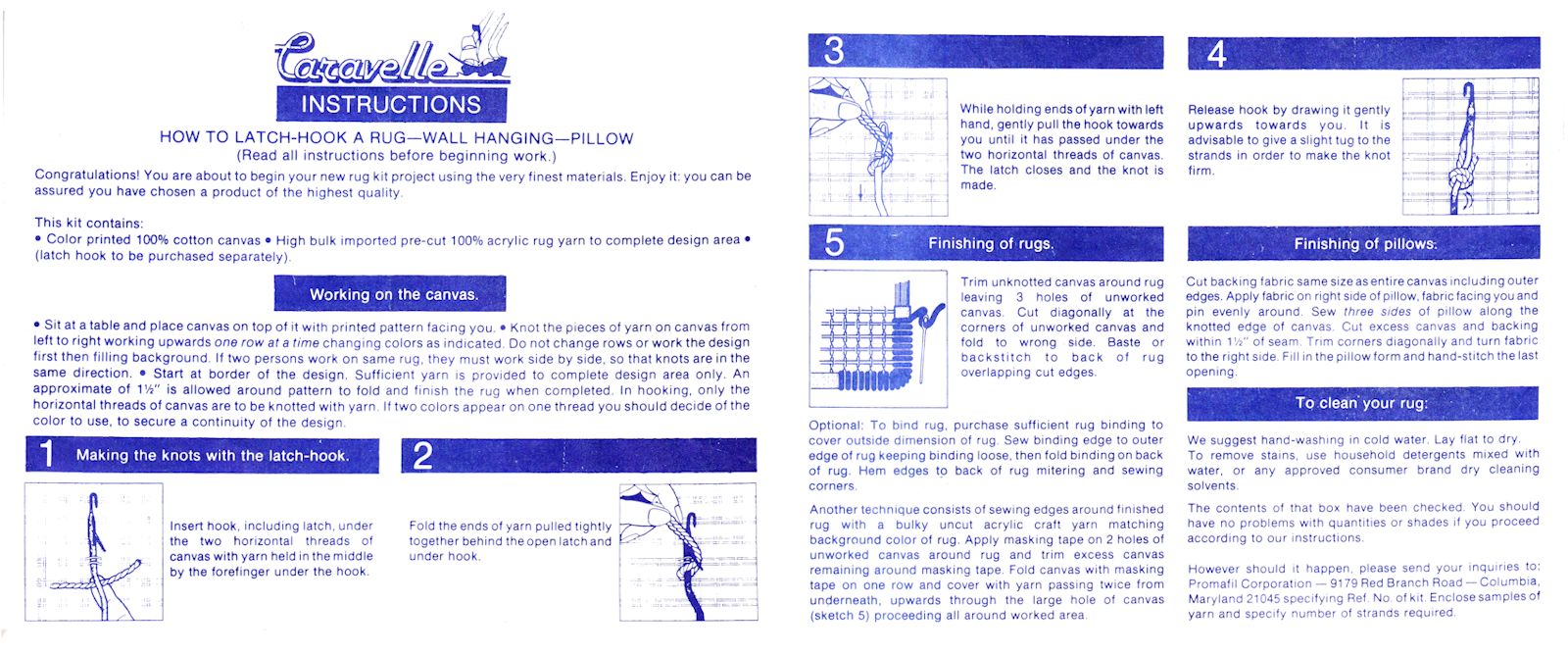
Sears included latch hook rugs in their famous catalogues.
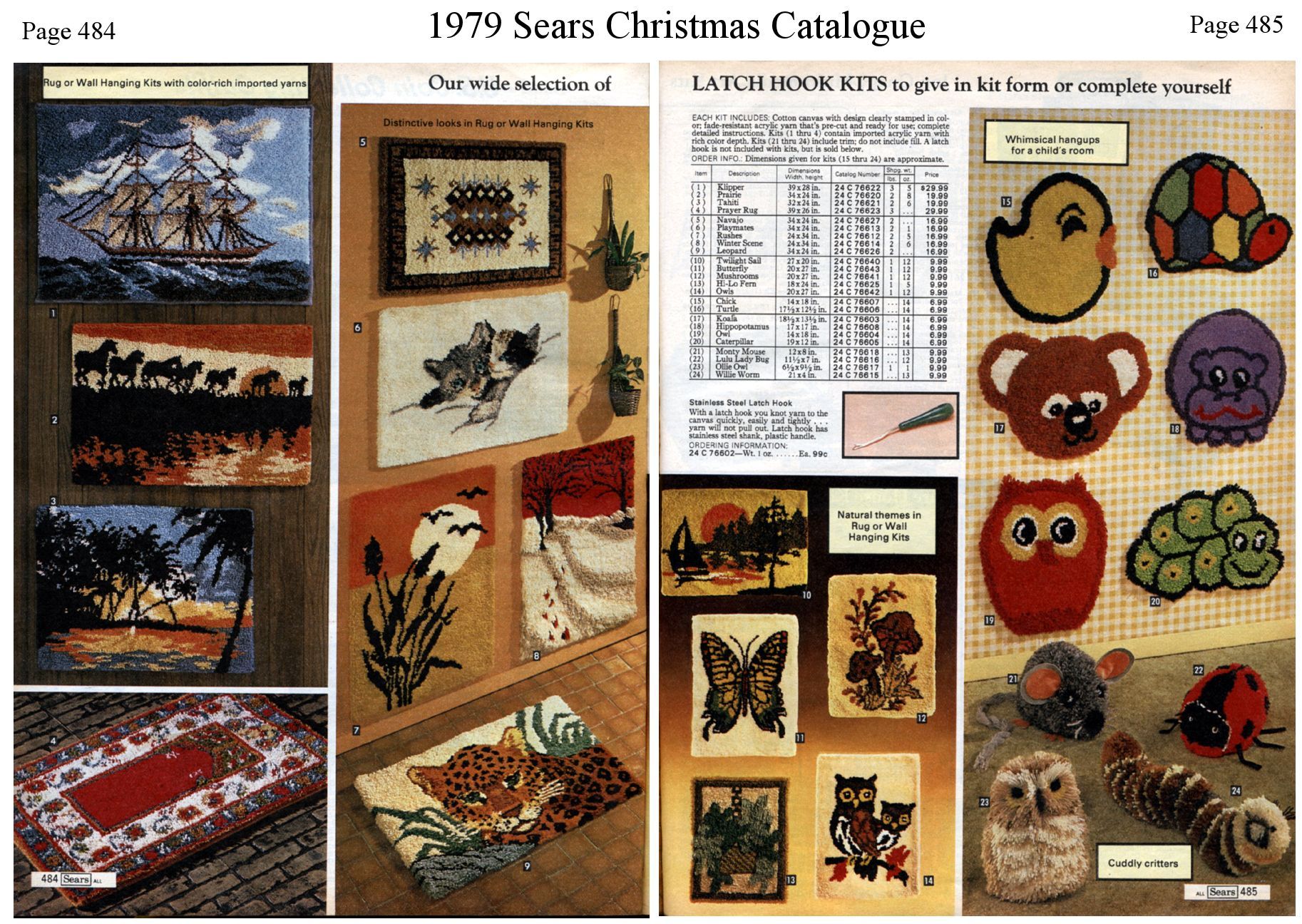
Scheepjes is a Dutch company, and like Readicut the brand has been revived. The Scheepjeswol brand began in Veenendaal in the province of Utrecht around 1750 when wool processing became the region’s most important industry. Prior to that, the area was known for the peat industry until the peat beds were exhausted. In 1799, Dirk Steven van Schuppen was a wool comber employing thirteen helpers. He bought untreated wool which was processed, dyed and woven. In 1855 it became “Widow D.S. Van Schuppen and Son” and was run by his widow and widow and their seventeen-year-old son. In 1885, Van Schuppen’s Wool Business employed nearly 300 people. In the 1930s, despite global recession, the company invested in new premises and rebranded as “Scheepjeswol.” In 1949 the company received a royal warrant and at its height, in 1962, Scheepjeswol had 900 employees. In the latter part of the 1960s, wages in The Netherlands increased rapidly – 10% per year for several consecutive years at Scheepjeswol – and this was not allowed to be passed on to the customer. A five-day working week was introduced and production fell. In the 1970s Scheepjeswol had to compete with cheaper products from outside of Europe and a shrinking market. In 1988 Scheepjeswol declared bankruptcy and in 1989 their Veenendaal factory was demolished and redeveloped as housing and a shopping centre. , the buildings on the factory site in Veenendaal were torn down. That seemed to be the end of the 190 year old company, but the brand-name still had value. In 2010 the Scheepjeswol brand name was acquired by the family-owned business De Bondt, a haberdashery wholesaler in Tynaarlo, Drenthe, reviving it as a Dutch brand. Nowadays, Scheepjes is a well-known brand of knitting and crochet yarn and also produces cut-packs of rug wool. Its logo is a ship based on a “Samoereus”, an inland vessel used to transport peat from the bogs around Veenendaal as well as other goods. This ship also appears on Veenendaal’s coat of arms and refers to the town’s original industry of peat-cutting.
Schoeller Handarbeiten (Schoeller Handicraft) was another German company that used to produce latch-hook rug kits in addition to manufacturing Smyrna carpets. In 1854, Leopold Schoeller founded a carpet-making company, Gebrüder Schoeller in Düren. Their trademark was an anchor. The company now appears to be part of Schoeller & Stahl, a textiles, knitting and handicraft company, but I haven't been able to find any further information about their latch-hook kits.
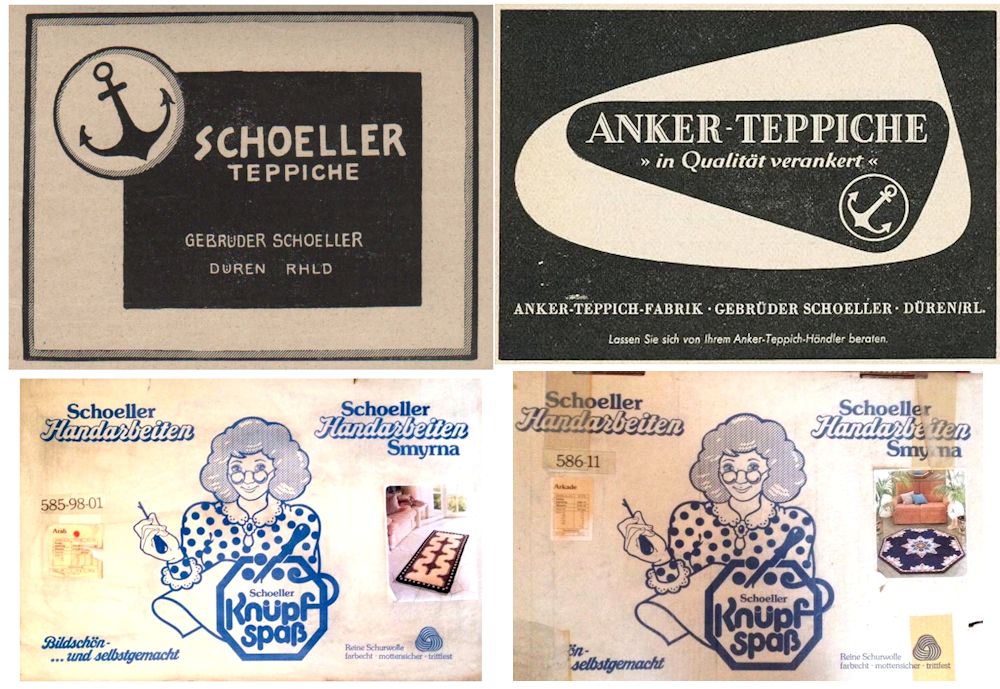
Smyrnalaine was a Belgian company producing bilingual Dutch/French "Albums." I noticed that some of the designs were very close to Patons designs.
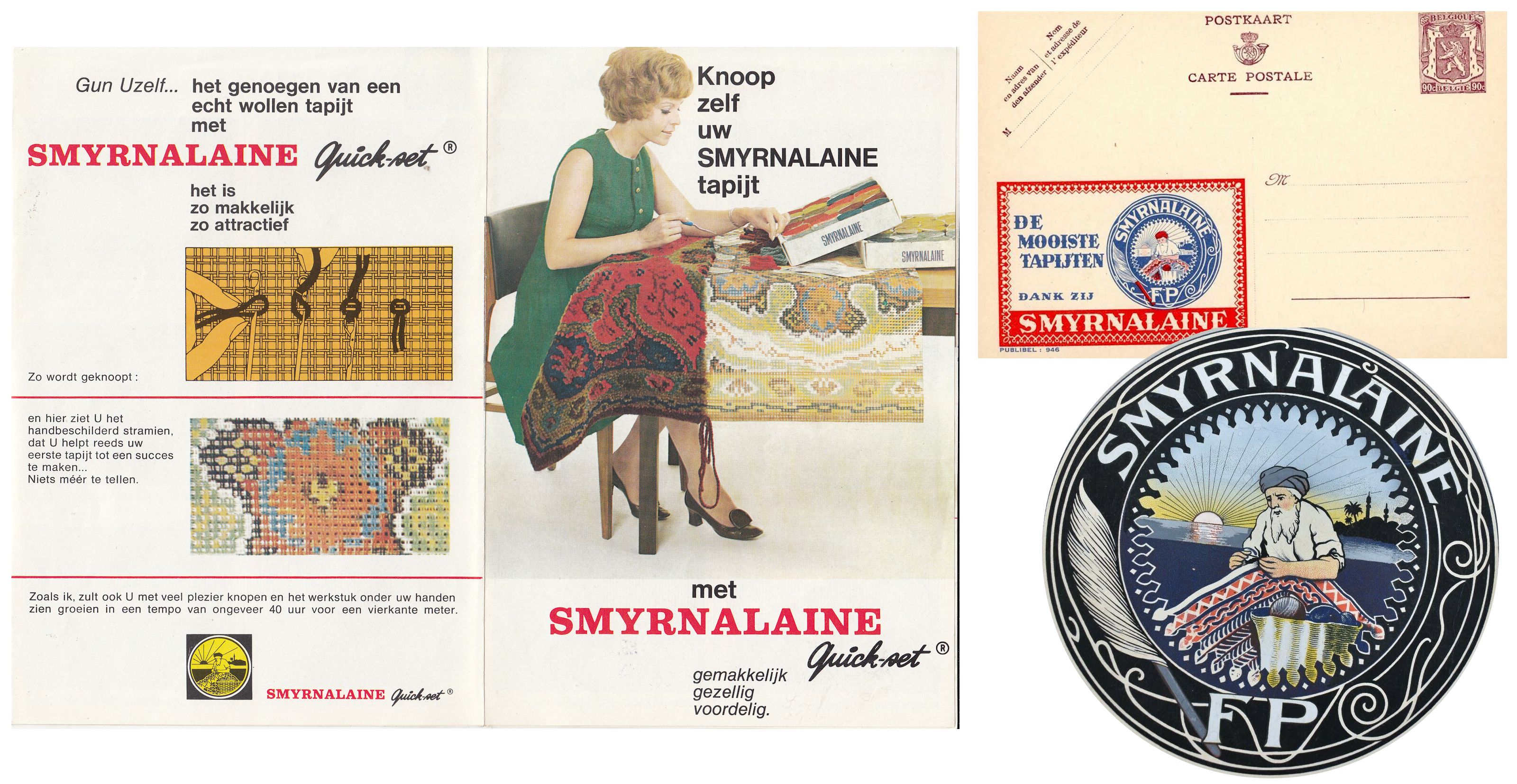
Teddy Wools & Teddicut Rug Wool were made by Donald White (Yarns) Ltd, 33 Pine Street, Bradford. The earliest mention I could find was in 1948. In the 1970s, the Teddy Wools trademark was owned by V. & A. Spinning Co. (Cullingworth) Ltd, Globe Mills, City Road (or White Abbey Road), Bradford, incorporated in Feb 1971 and dissolved August 2013. V. & A. Spinning Co appears to have been part of Dutton Yarns Ltd. City Road and White Abbey Road are now part of a trading estate. .
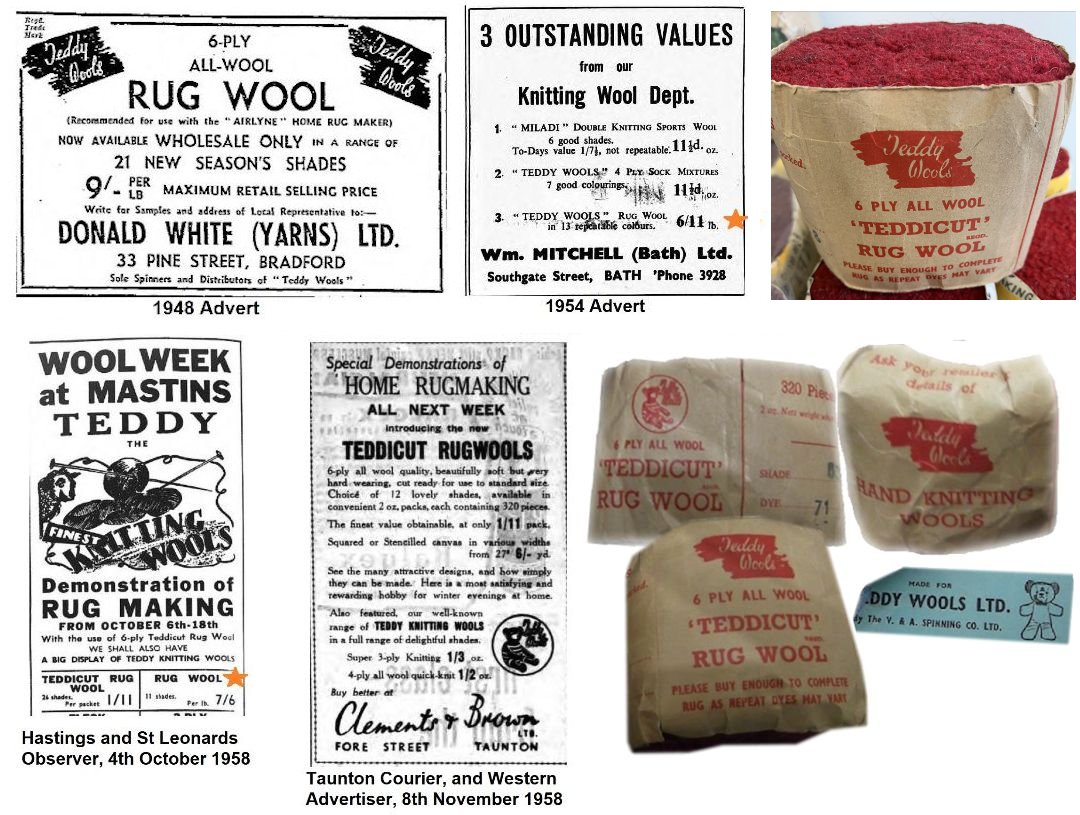
Texet This one is a bit of a mystery. They produced rug wool.
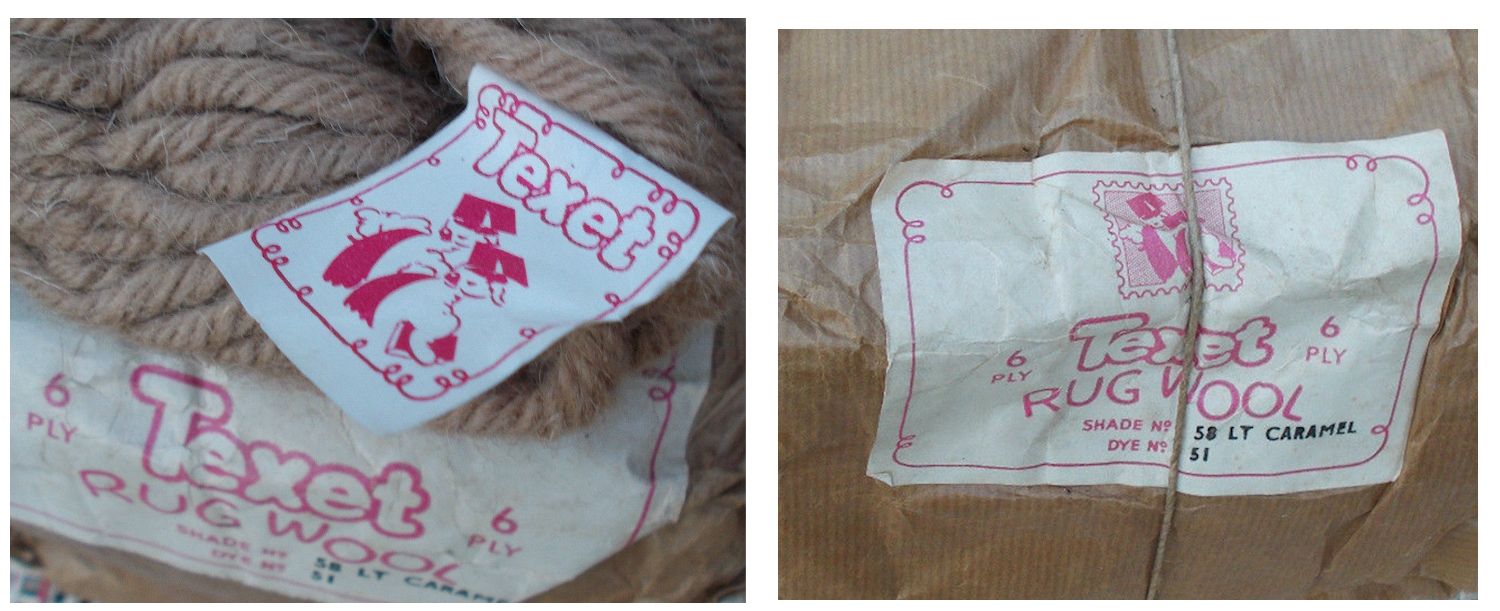
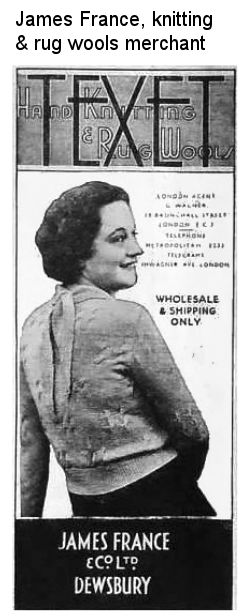
Till's Yorkshire Wools Ltd are a bit of a mystery. They were registered as company no. 00370410, but there are no details available on its registration date or dissolution date. They failed to file accounts in 1970. They manufactured skeins of 6-ply rug wool under the name of Grenadier.
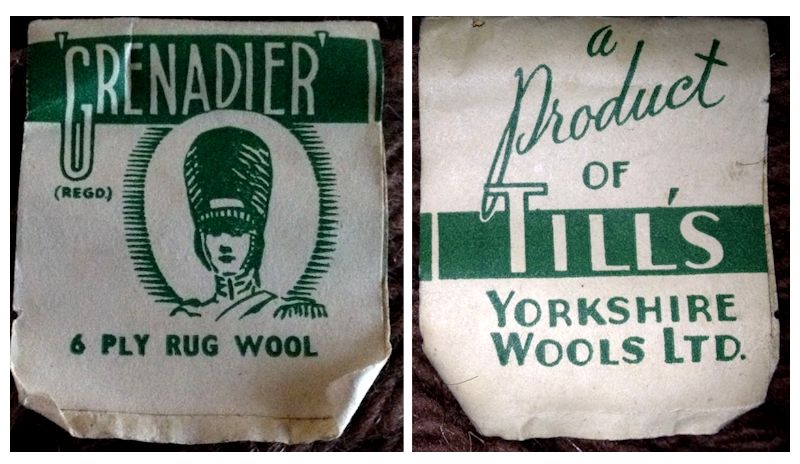
Vicars' Rug Wool. I don’t know much about this apart from a Vicars' “Pera” Rug Gauge Vicars' Latchet Hooks and my searches could only find “Vicars Woollen Mills” which was the first and largest woollen mill in Marrickville, New South Wales, Australia. Pera seems to have been a thinner wool (like Sirdar) where several strands were used at once to get the correct thickness. The original mill was founded by Thomas Barker in 1852 and taken over by John and William Vicars in 1871 (they originated from Tillicoultry, Clackmannanshire, Scotland). They relocated Vicars’ Woollen Mill relocated from a Sydney factory to Victoria Road, Marrickville in 1893. It was an important supplier to the military during WWI and was involved in benevolent work such as helping hospitals for convalescing soldiers. It was proud of its products “Made in Australia by Australians for Australians,” and played a large part in the rise of Australian woollen manufacturing immediately after WWI. Vicars Woollen Mills (John Vicars and Co Ltd) employed predominantly women, partly because of their more delicate hands and partly because a woman’s wage was less than half of a man’s wage. Vicars’ fulfilled extensive contracts during WW II and had additional factories in St Marys and Woonona, but increased competition during the 1960s and 1970s led to the mill’s closure in 1976. The Vicars’ Woollen Mills was incorporated into the Macquarie Worsteds Group in the 1980s.

|
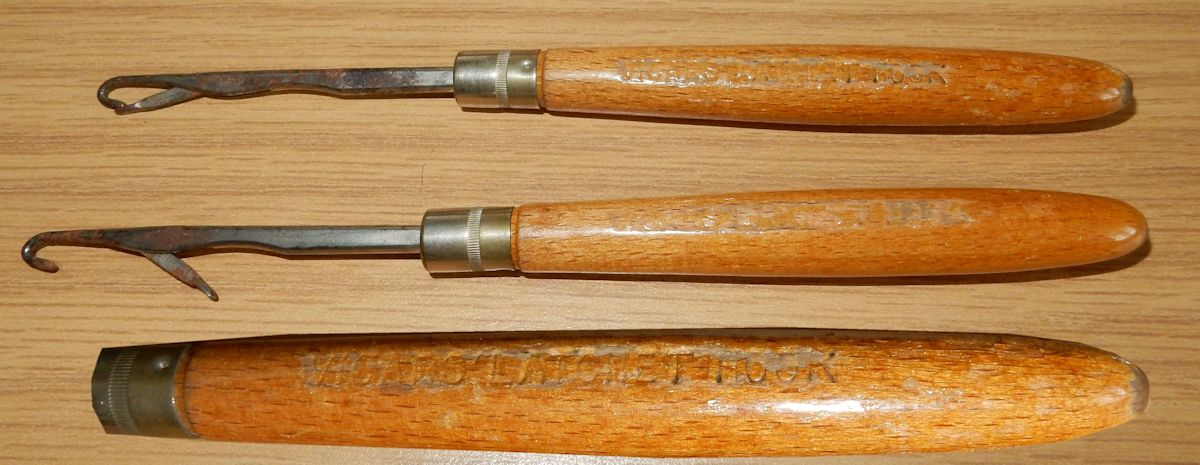
|
Vogart. Vogart Crafts Corporation was a United States corporation who did business from about 1930 until around 1990. In 199, its parent corporation, Pioneer Systems, Inc., caused it to file for bankruptcy.
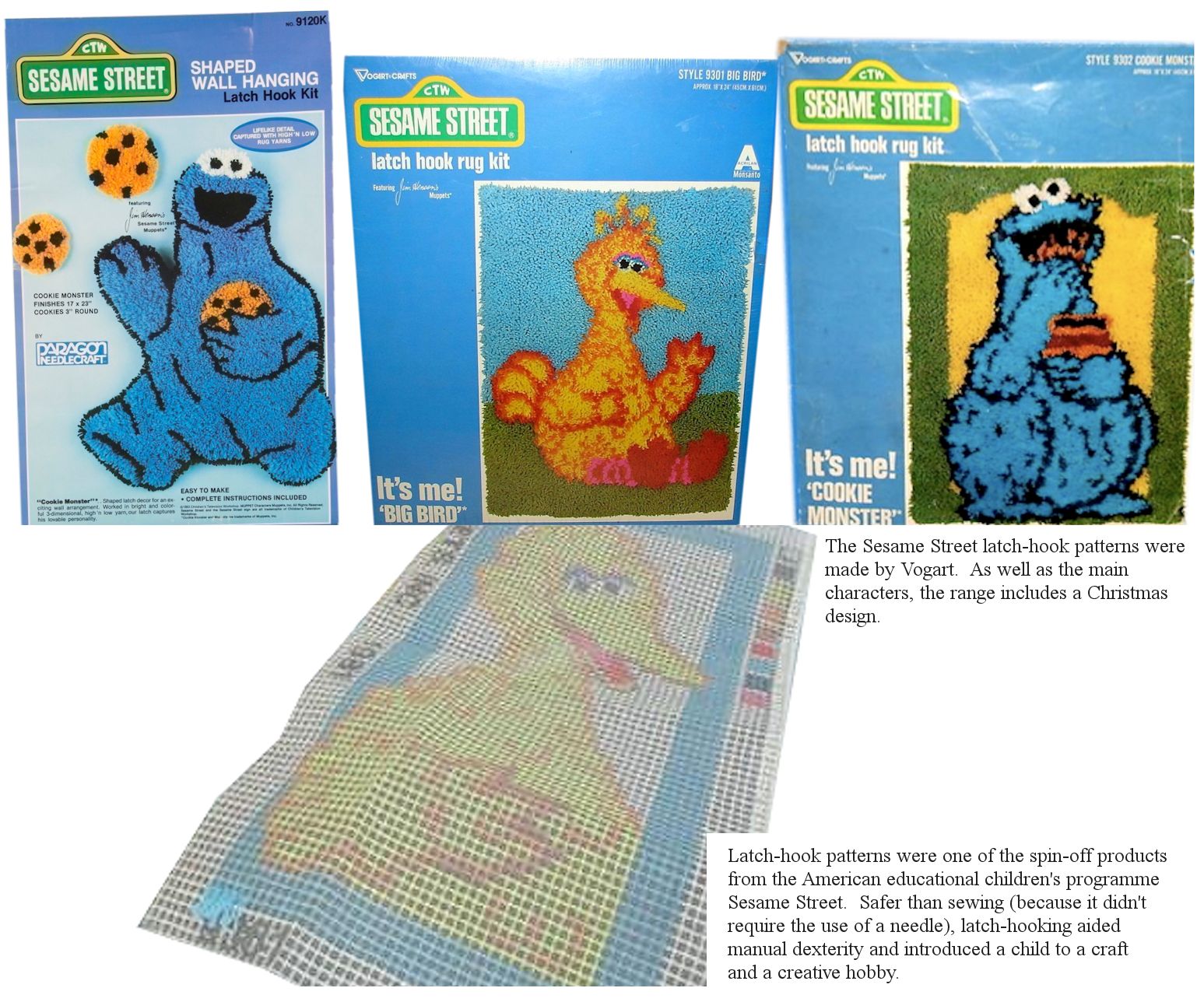
Walco / Edinburgh Royal. Walco Products Inc (Bronx, New York) sold 4 ply rug wool, both under the Walco brand and the Edinburgh Royal brand. Walco were primarily involved in crafts relating to beading, including beaded doll kits and ornaments (Walco Bead Co was one of the largest bead companies in the United States at the start of the 1900s), but late expanded into other craft supplies. In 1976, its bead-craft division became part of Holiday Industries. Walco Products Inc is listed as "merged out" as of 1979 and the Walco "flower" trademark expired in 1991.
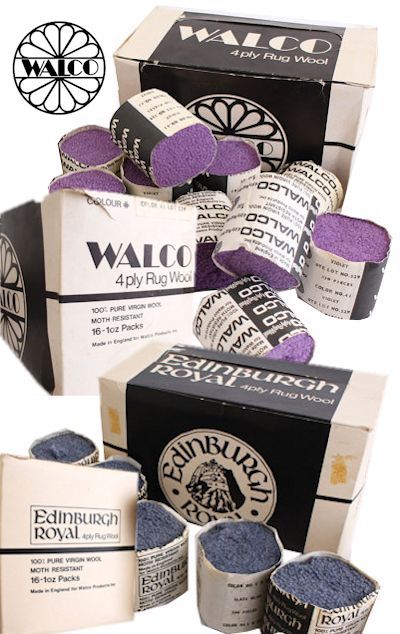
Other brands sometimes found in charity shops are Cronit Melrose (wool/polyester mix) and Bernat Tabriz (polyester yarn), both sold in ready-cut strands. Cronit Melrose 6 ply 52% wool/48% nylon wool yarn was available uncut "also suitable for macrame" or in packs of 160/320 pre-cut pieces.
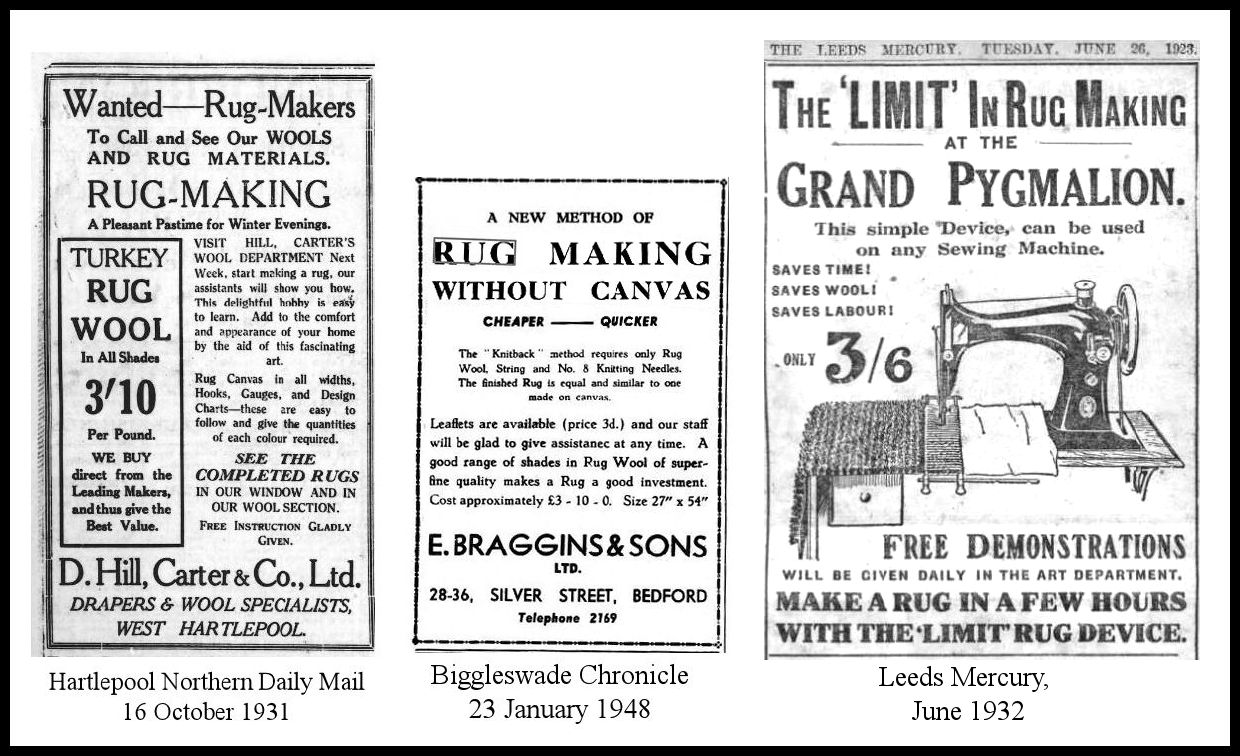
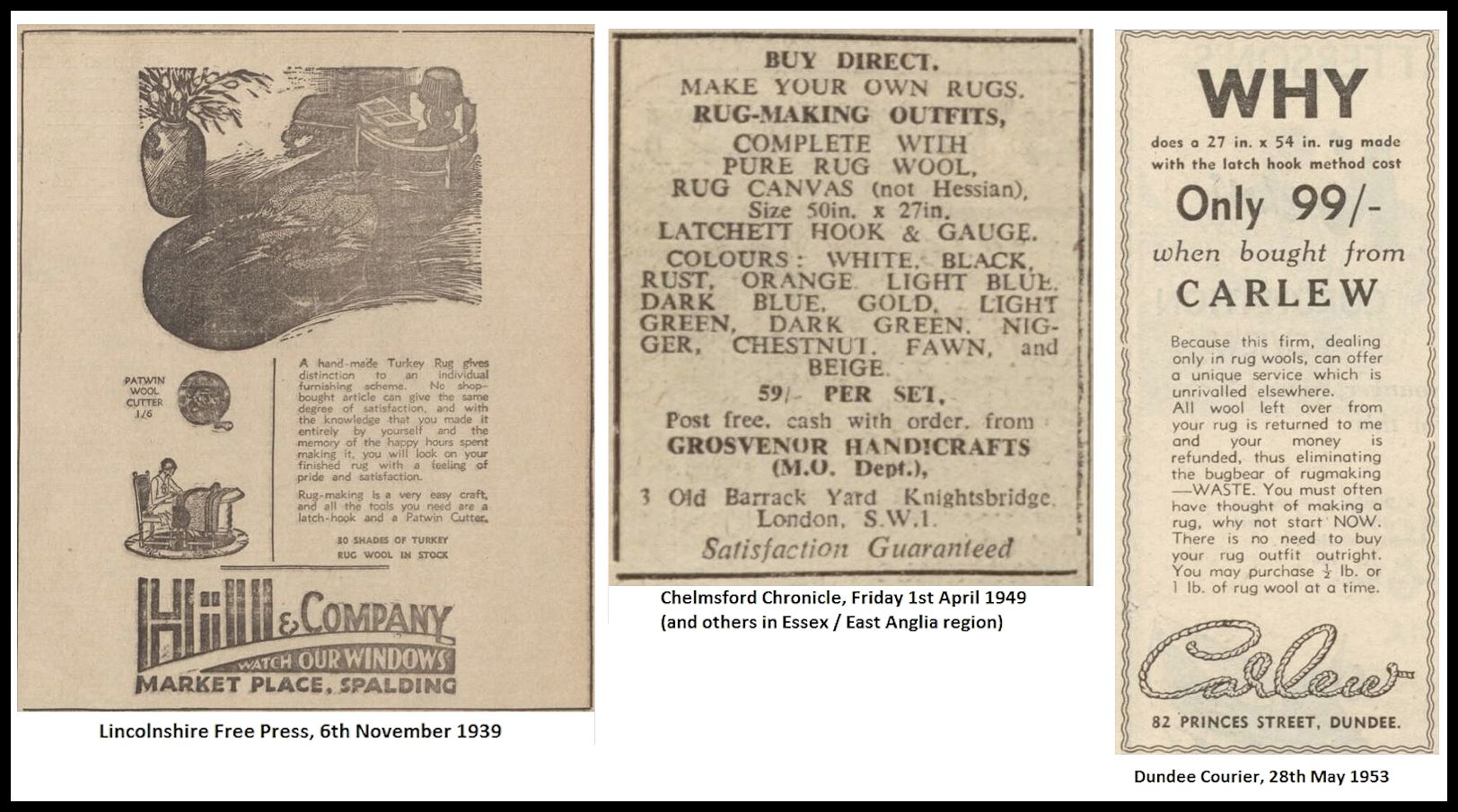
|
THRUMS "Thrums" was originally a northern British term for textile waste, for example the tail-ends of the warp thread left behind when a finished carpet was cut from the loom. A thrum was any short piece of waste thread or yarn, or a tuft or fringe of such pieces. These were collected together and sold by weight, making it an economical way of buying rug wool. Iriss of Penzance still do something very similar with their bargain bags of leftovers from the wool-cutting process. The thrums sold by Stoddarts of Halifax came from the Axminster carpet industry. Although there would be enough yarn, sold by weight, for a rug, the colours in each bargain package depended on the pattern of the carpet they had come from. You could either make a random coloured rug ("Scrambled Egg" pattern as Stoddarts called it) or buy a printed canvas designed to be used with thrums. With the pre-printed canvas you didn't match the yarn colours to the canvas colours, but instead worked the pattern according to how much you had of each colour yarn.
Unless you were making a random coloured rug, the first task was to sort the thrums by colour. For most of us, this meant e.g. blues, greens, reds rather than into exact shades. These then had to be cut to the desired length. The thrums were used 2 or more to a hole and Stoddarts suggested blending colours to make the best use of the threads. Because thrum means a tuft of yarn, some folks refer to all pre-cut rug-yarn as thrums, especially if it's bought in a mixed bag of leftovers, which isn't strictly correct as the thrums in this case would be the varying lengths of yarn left over from the cutting process! The use of thrums in latch-hooking goes back to when Workers in weaving mills were allowed to collect waste pieces of yarn (up to 9 inches long) that were useless to the mill. The weavers took these home and pulled the thrums through burlap or hessian sacking to make rugs. The two rug supply companies that sold thrums, along with tips on how to use them, were Jacksons of Hebden Bridge and Stoddarts of Halifax. Jacksons is still in the needlecraft business, but Stoddarts has vanished. There's a Scottish folksong "The Three Threads" that goes "Hirple, dirple, dirrum dum, Three threads and a thrum," where the refrain is supposedly what a cat is saying as it purrs. The term itself seems to come from the Old English word for a ligament (a sinewy fibre), via the Middle English "throm" meaning an endpiece. The Old English "thrum" is related to the Old High German "drum" and the Dutch "dreum" meaning a remnant, which may be related to the Old Norse "thromr"meaning a brim or edge. |
You are visitor number: